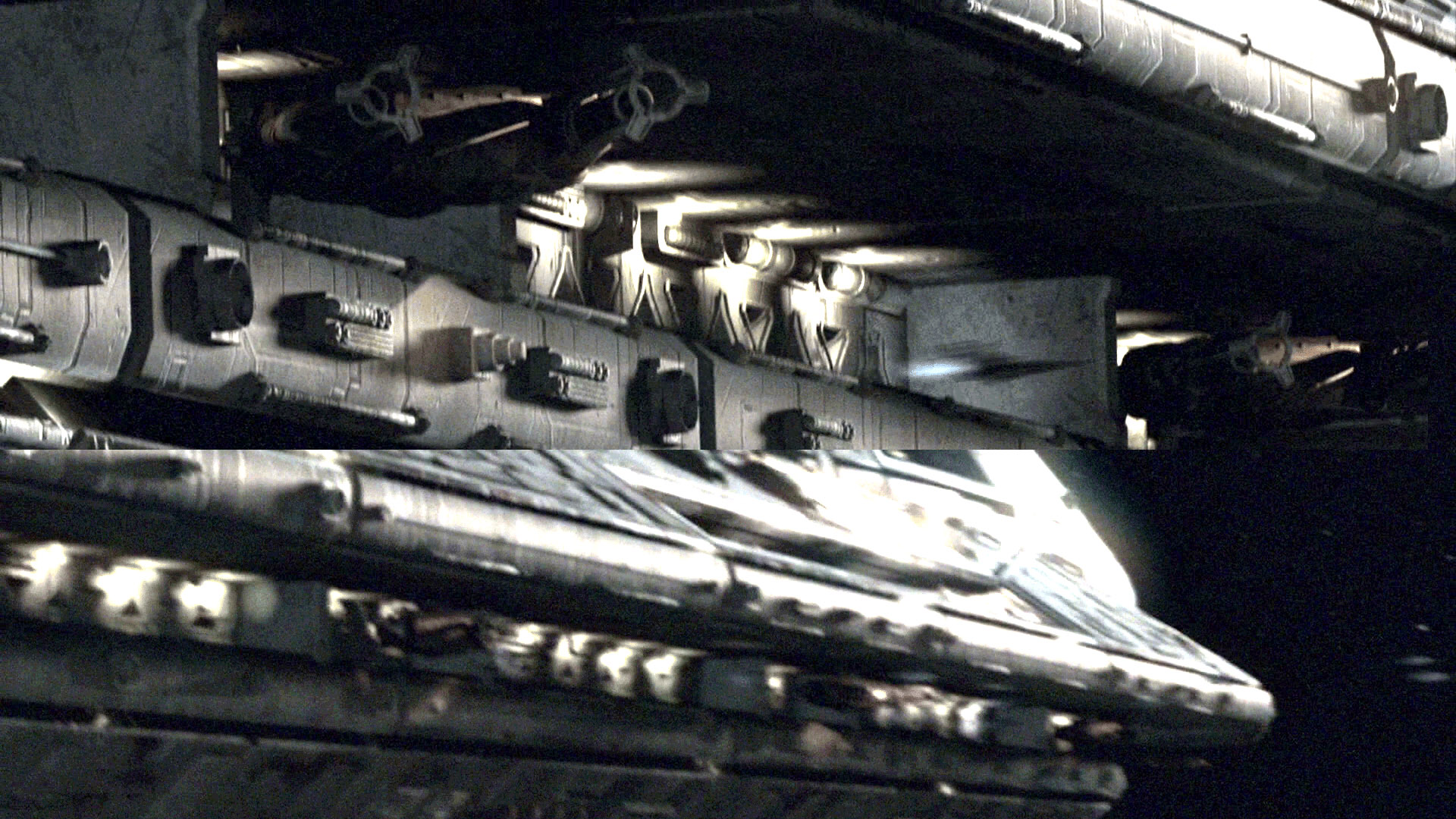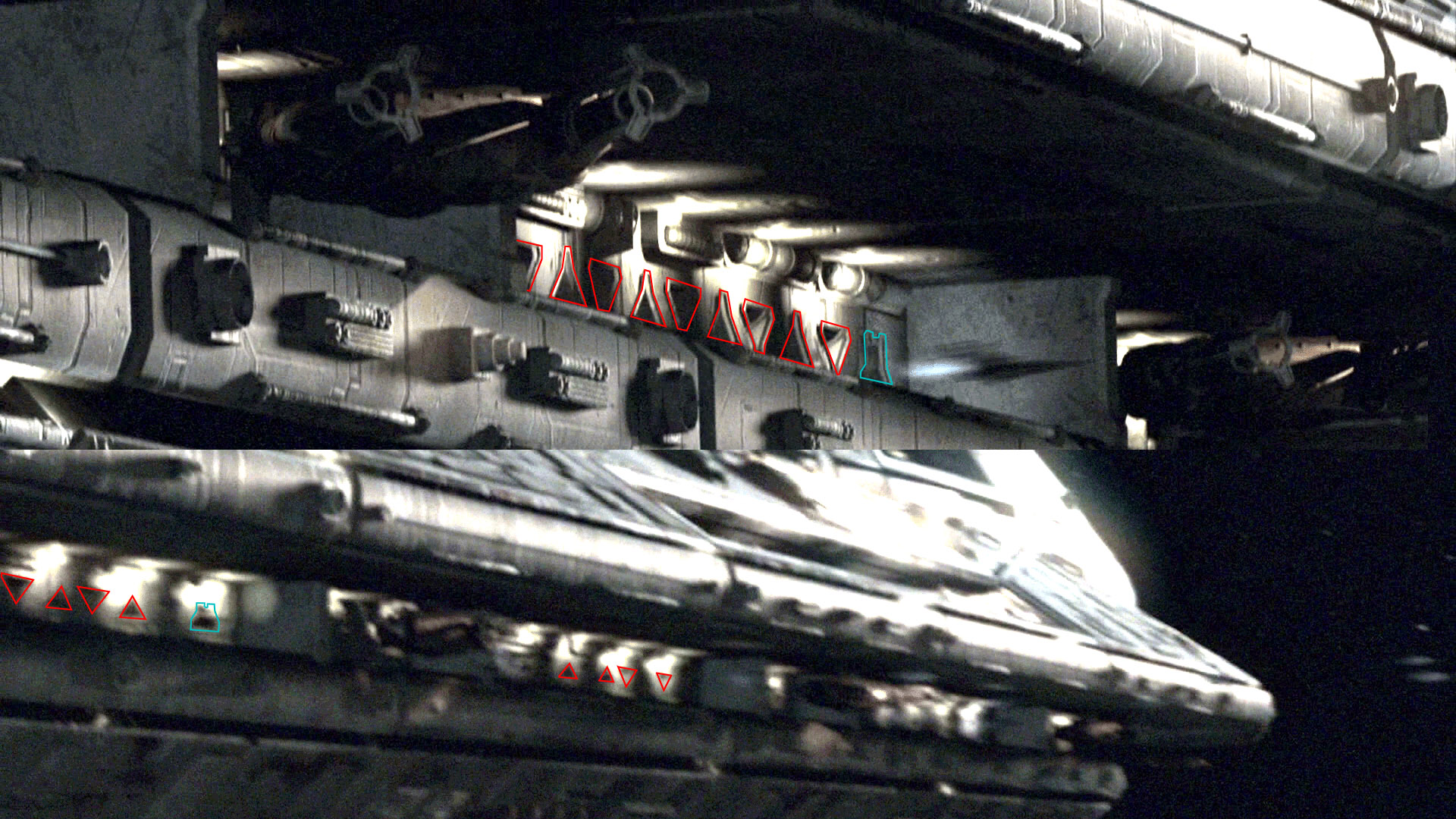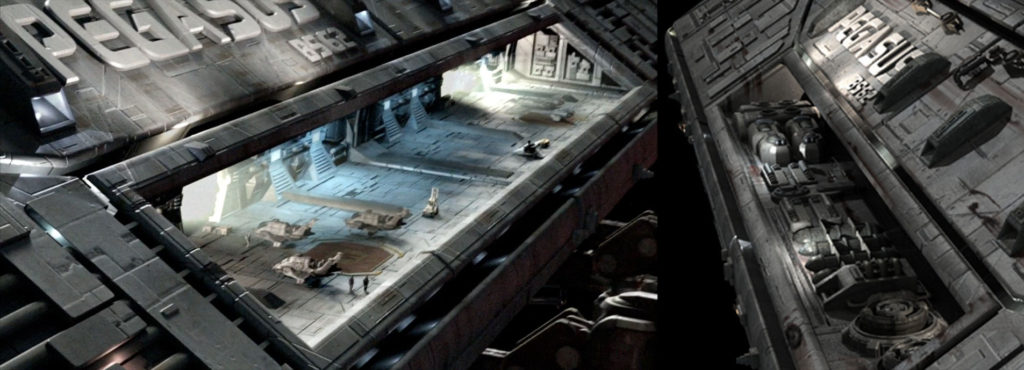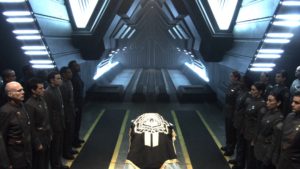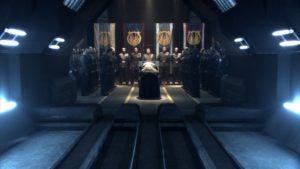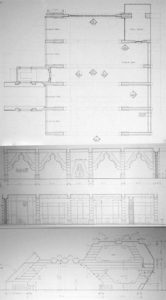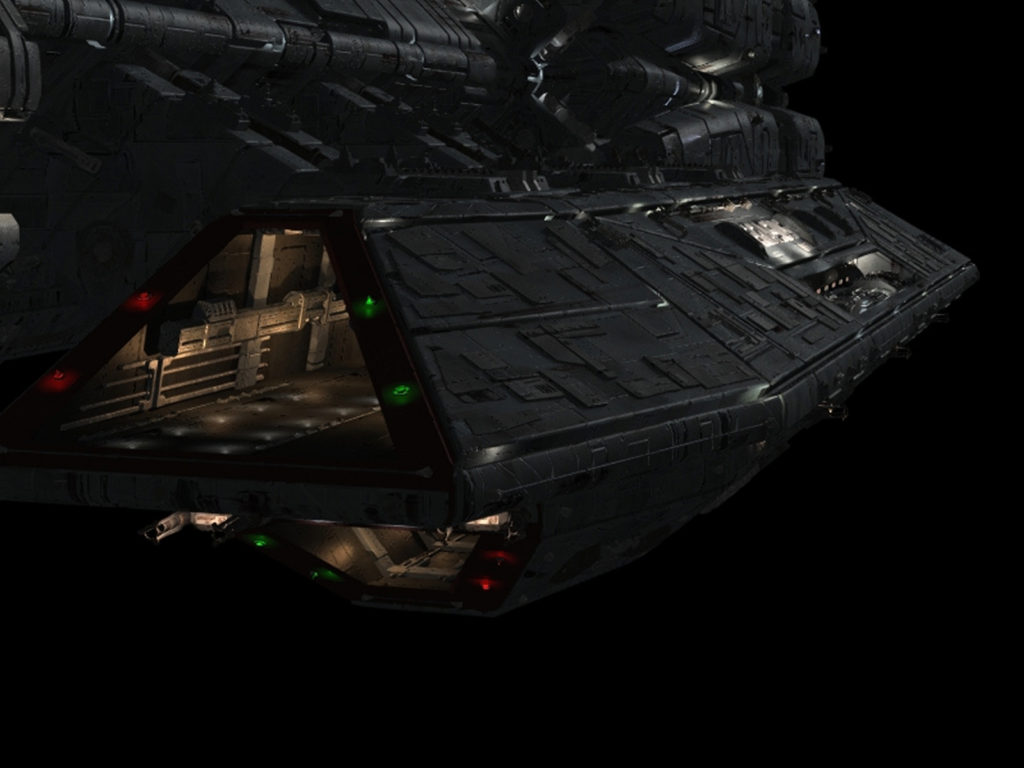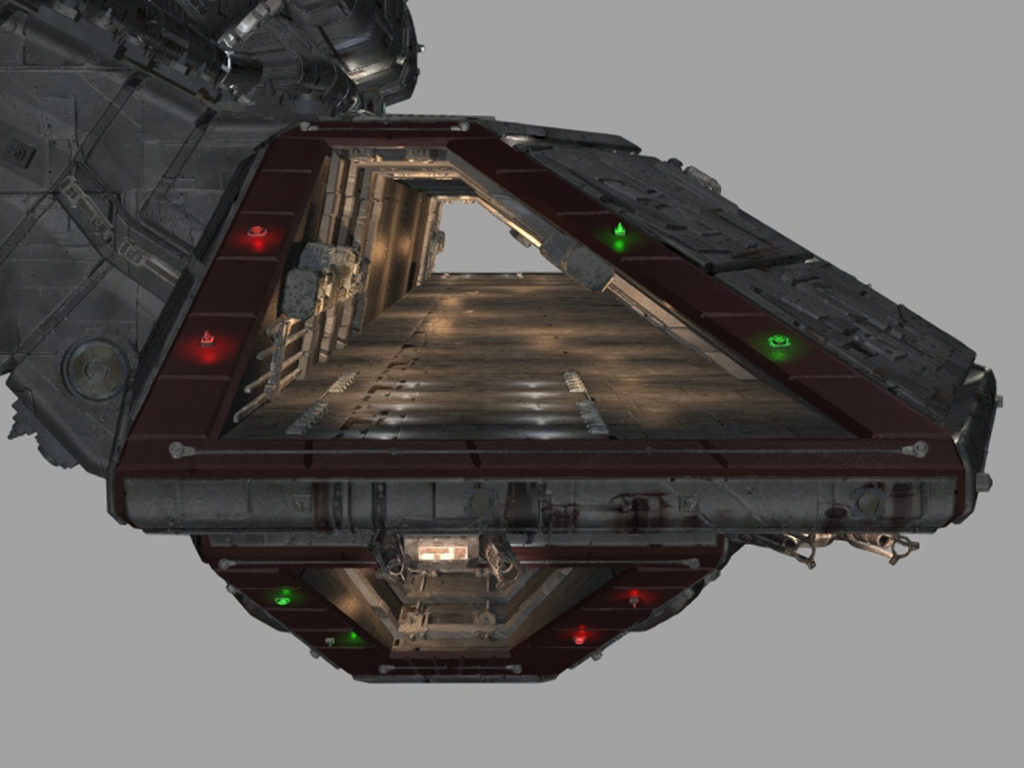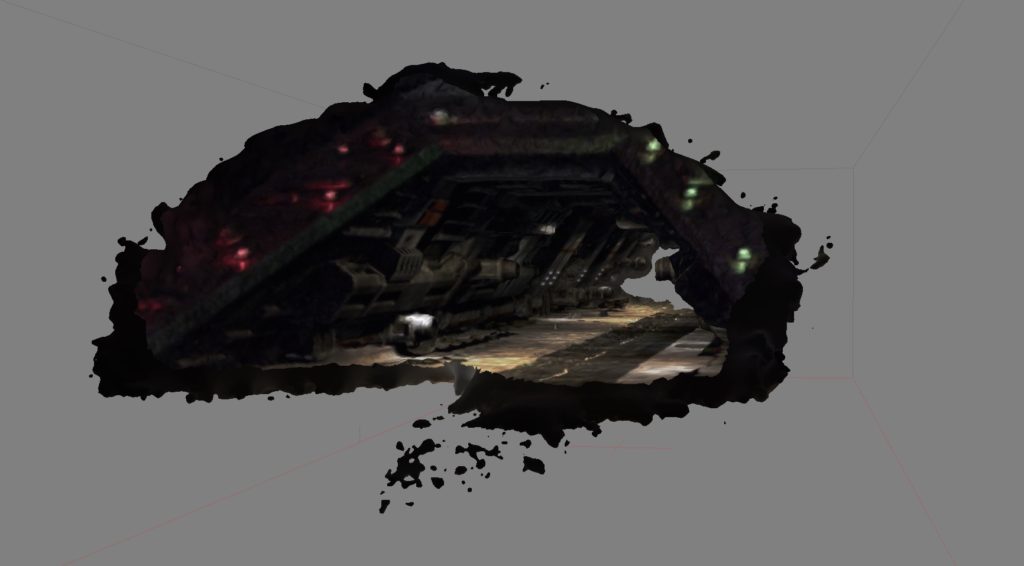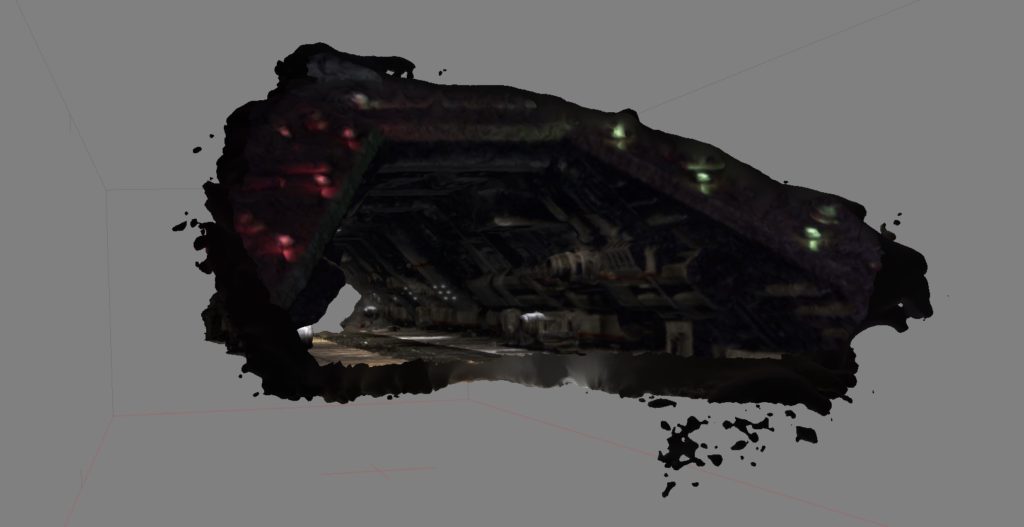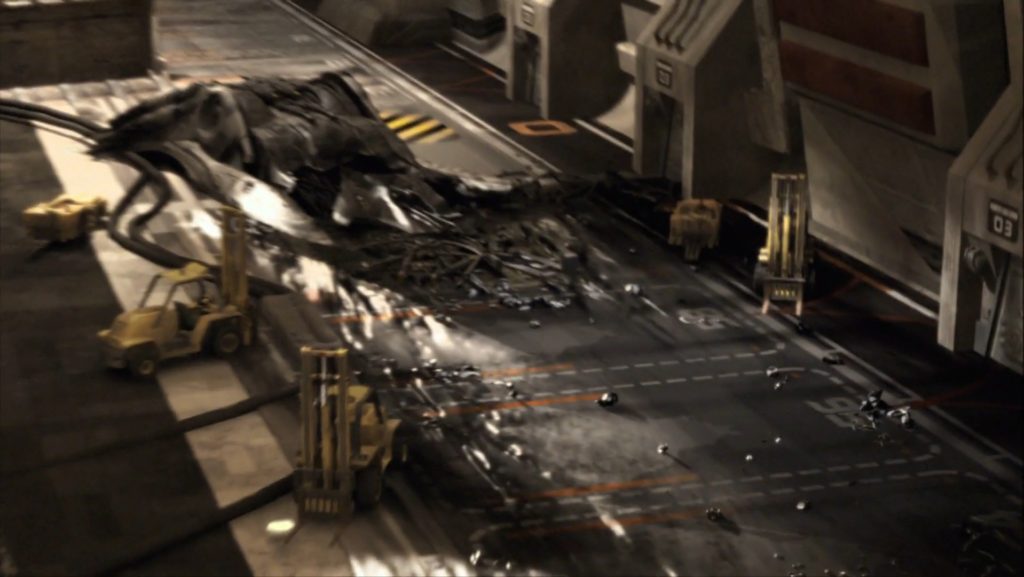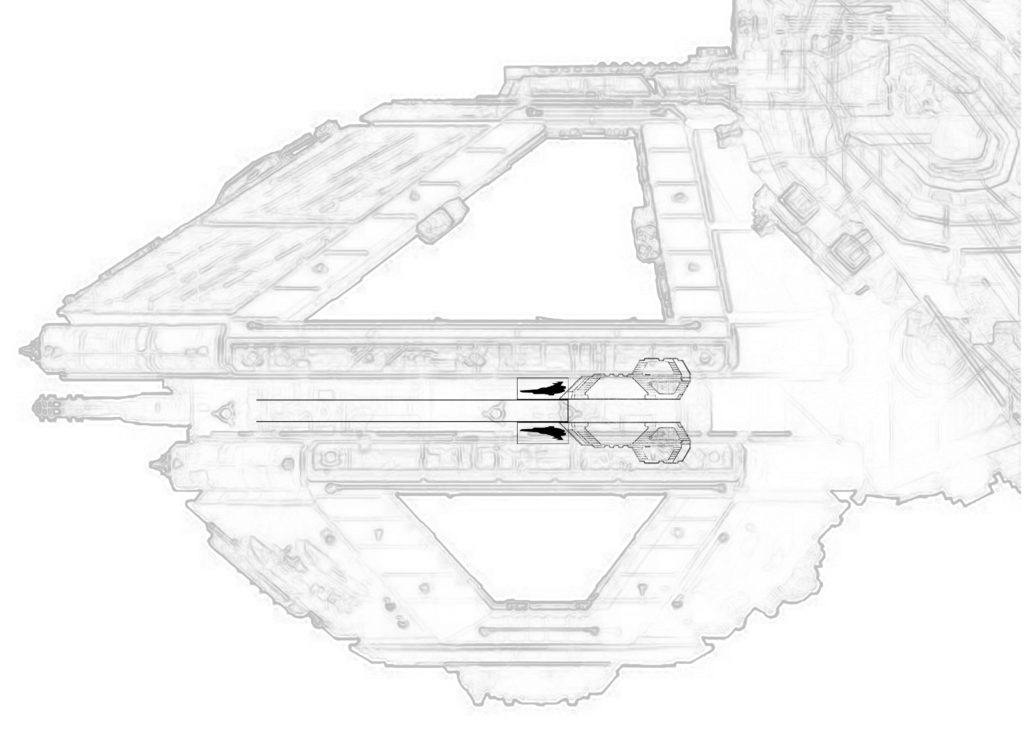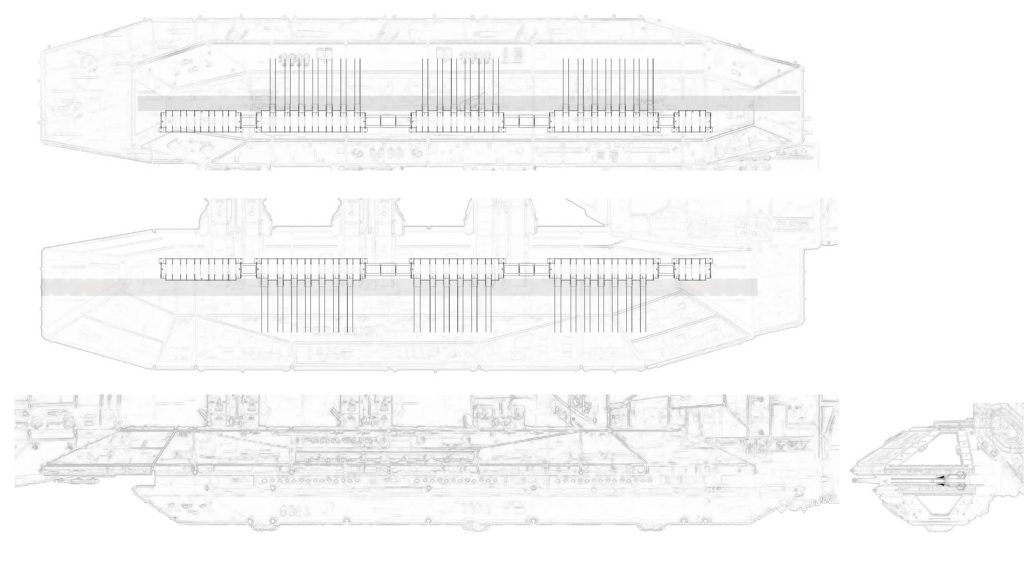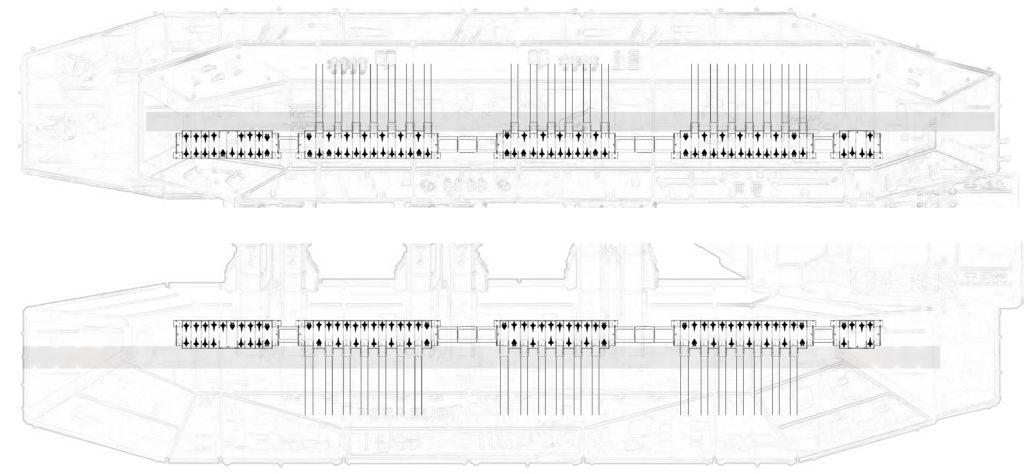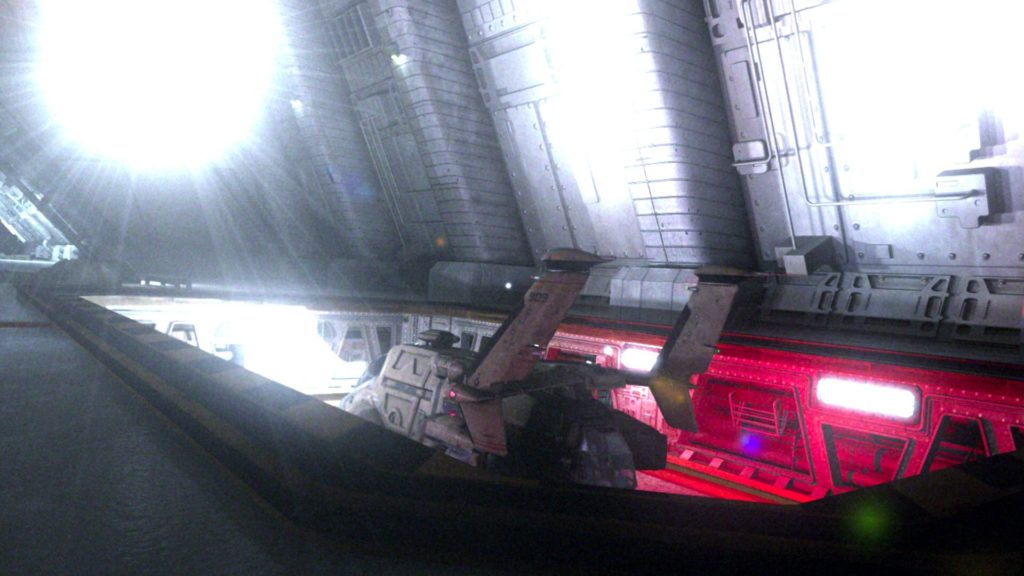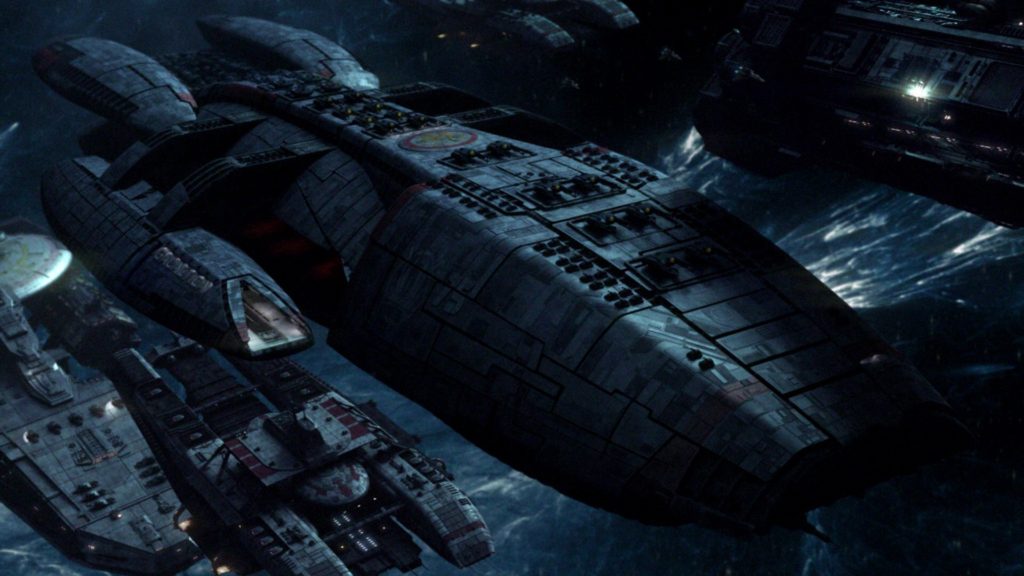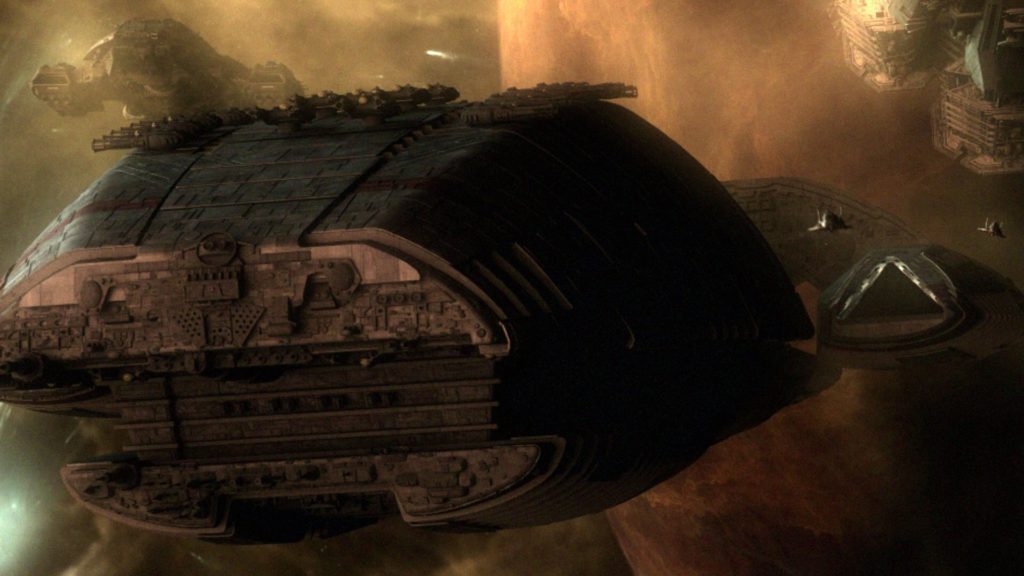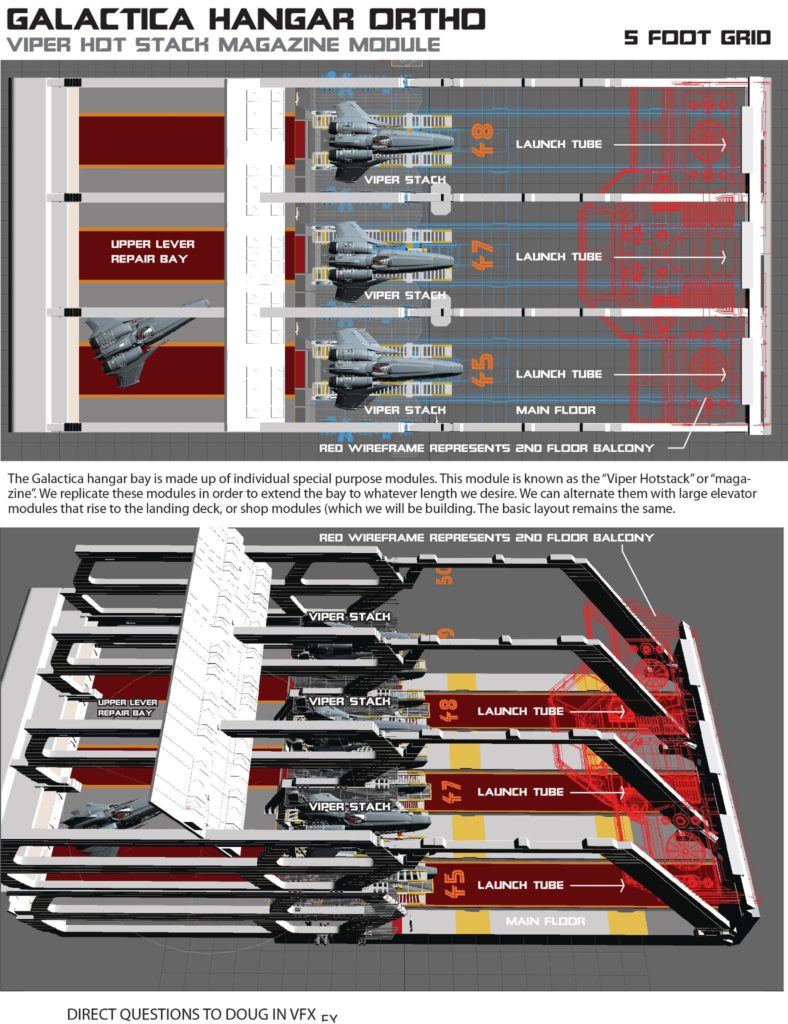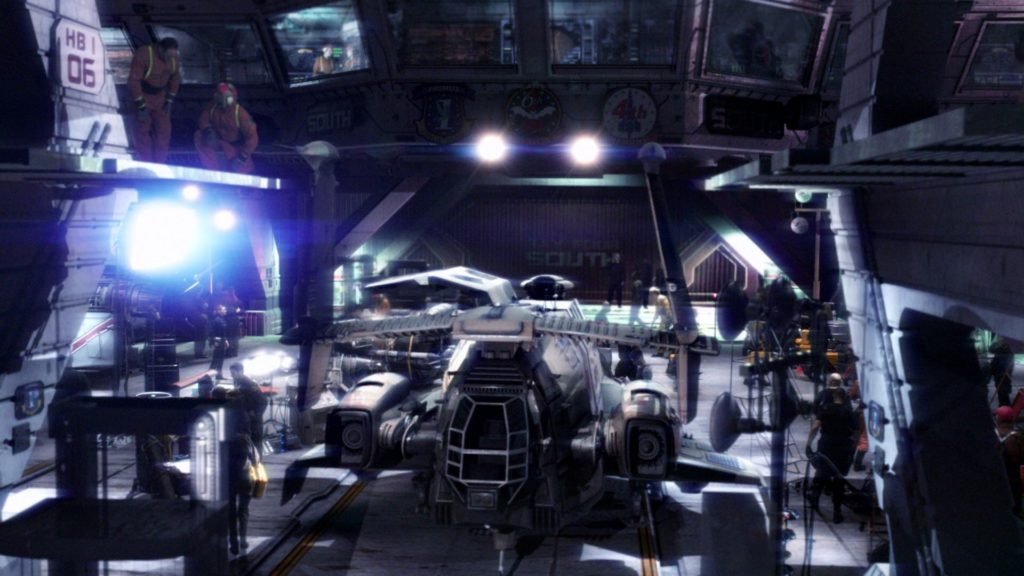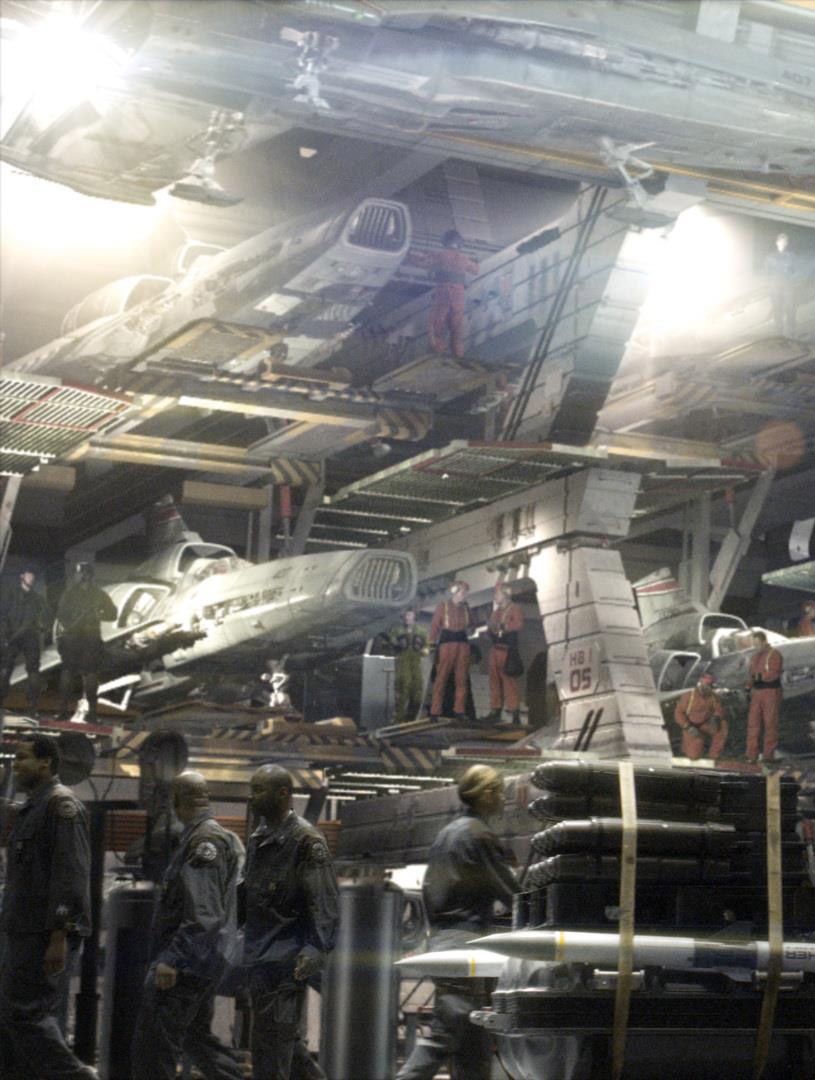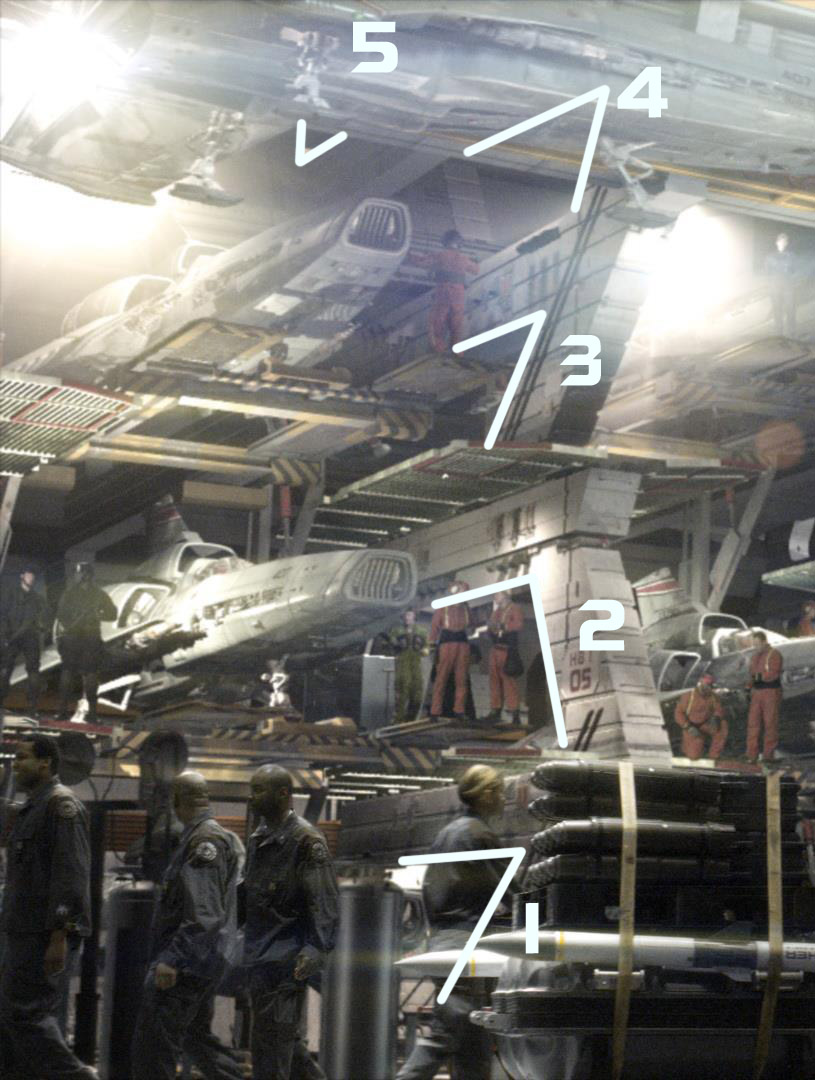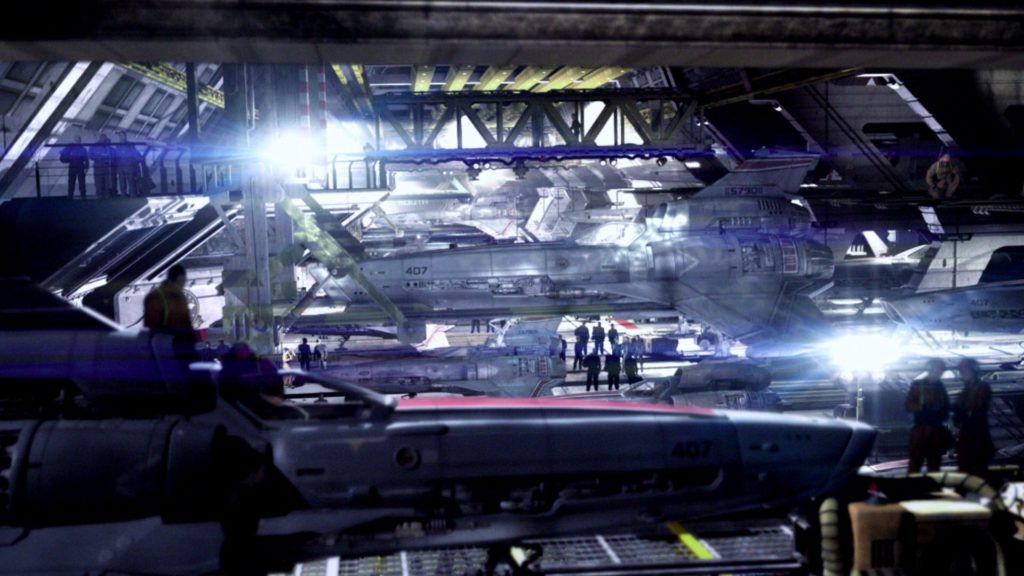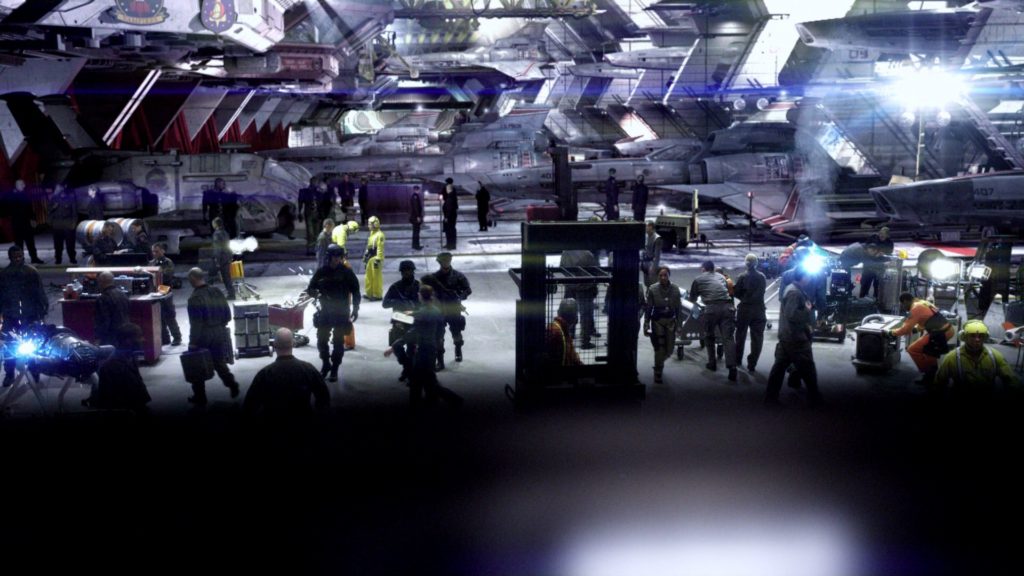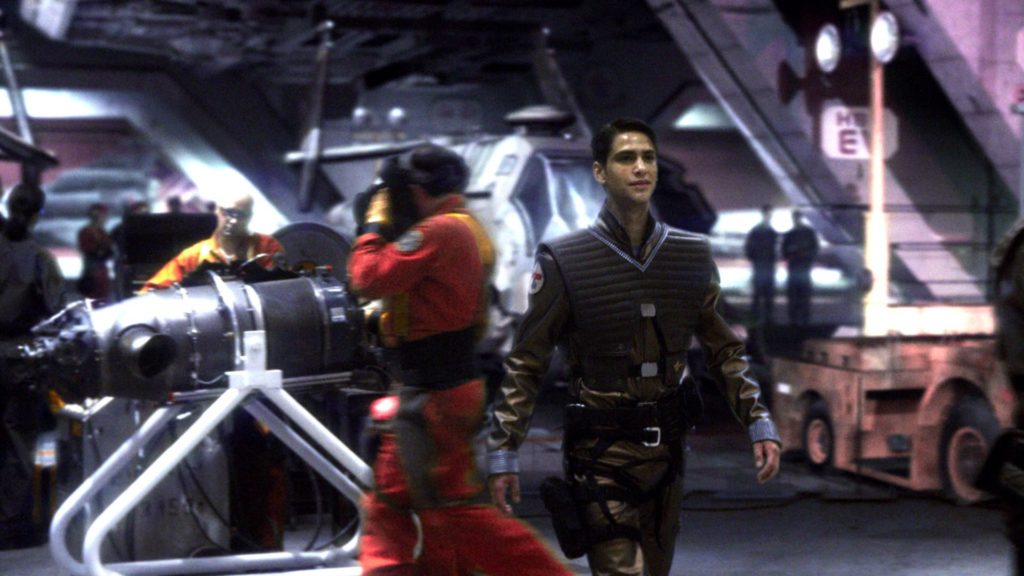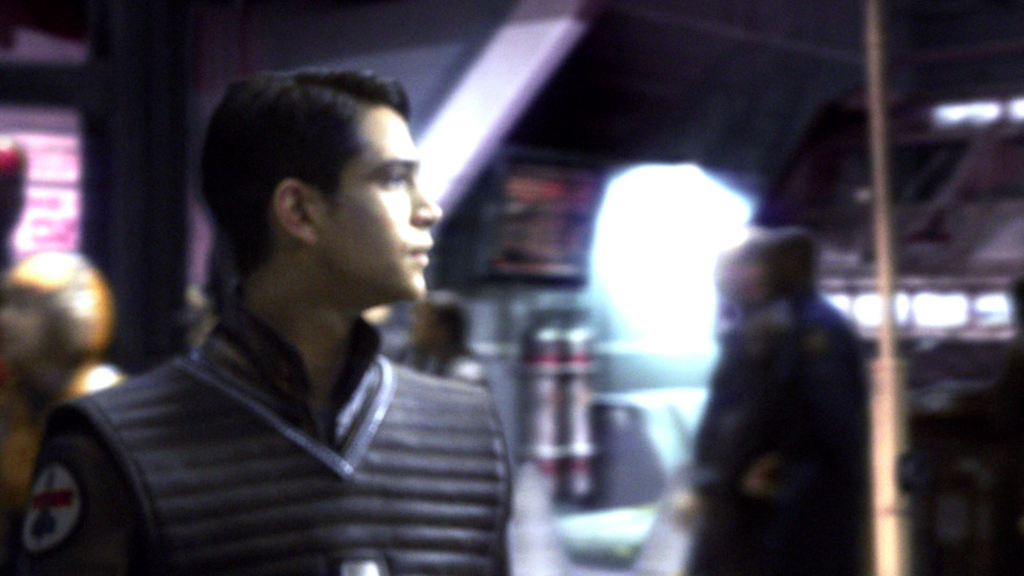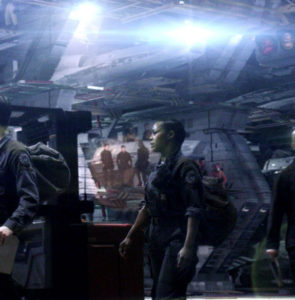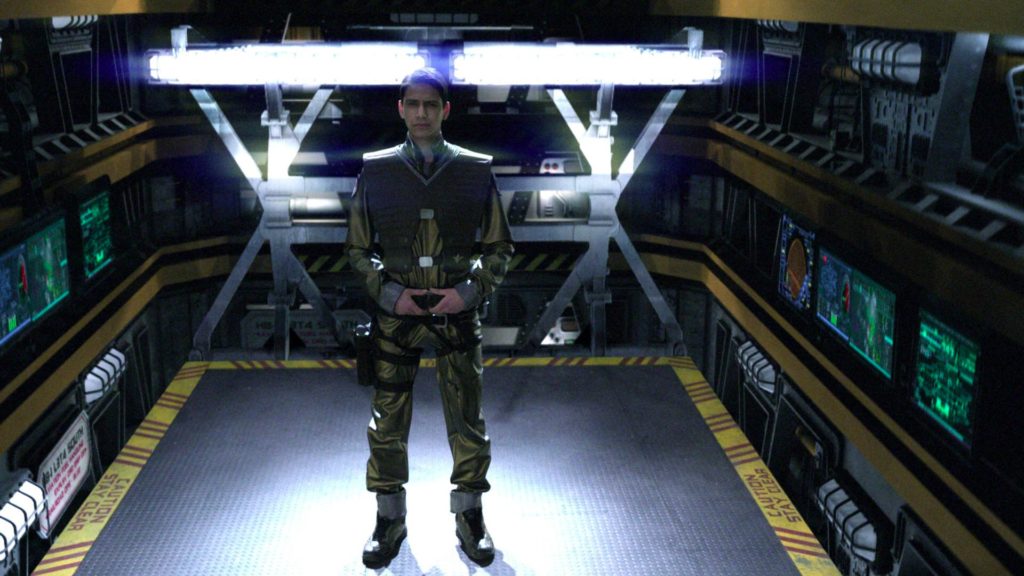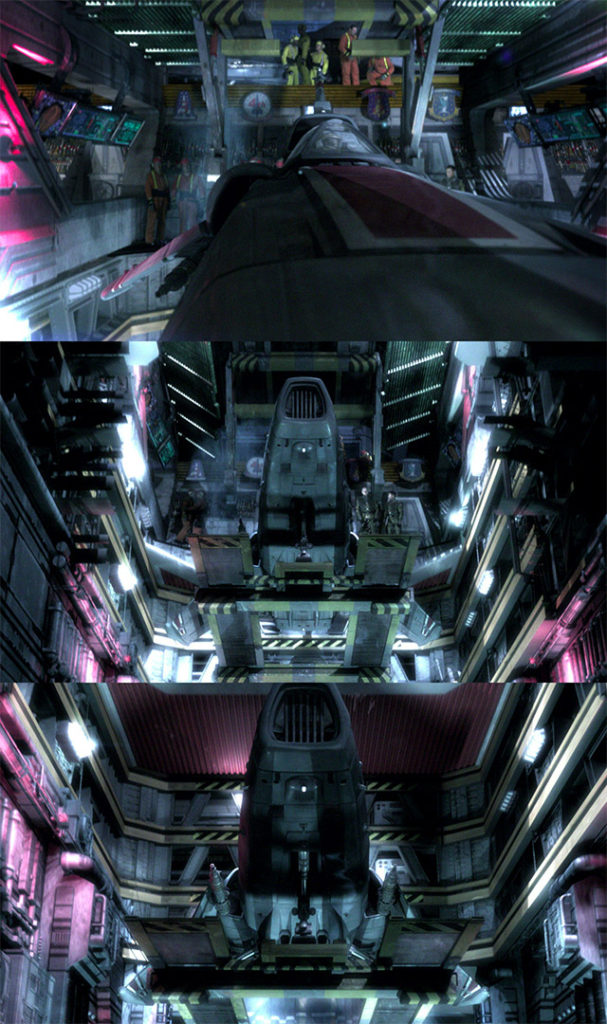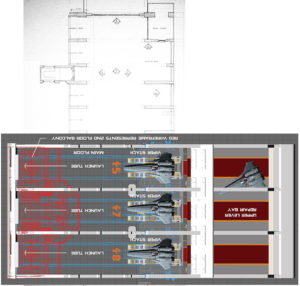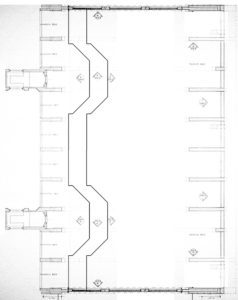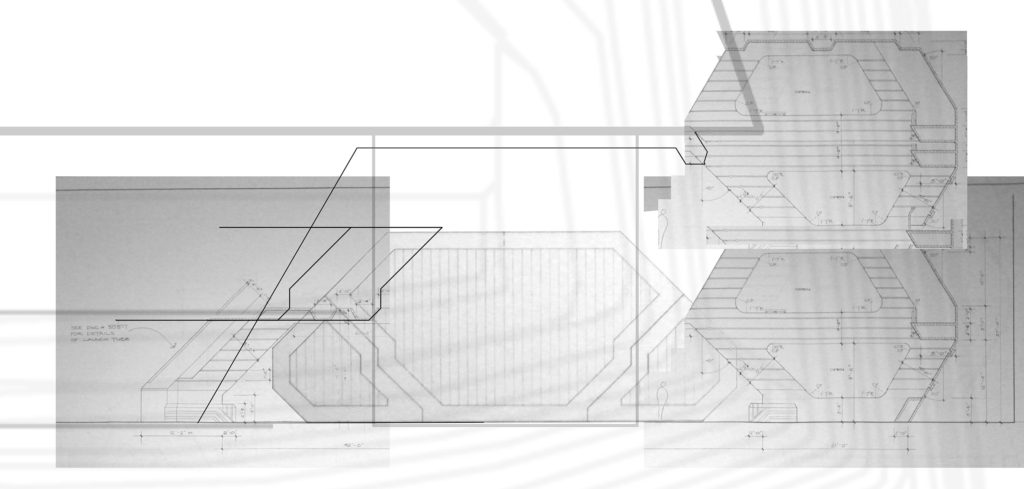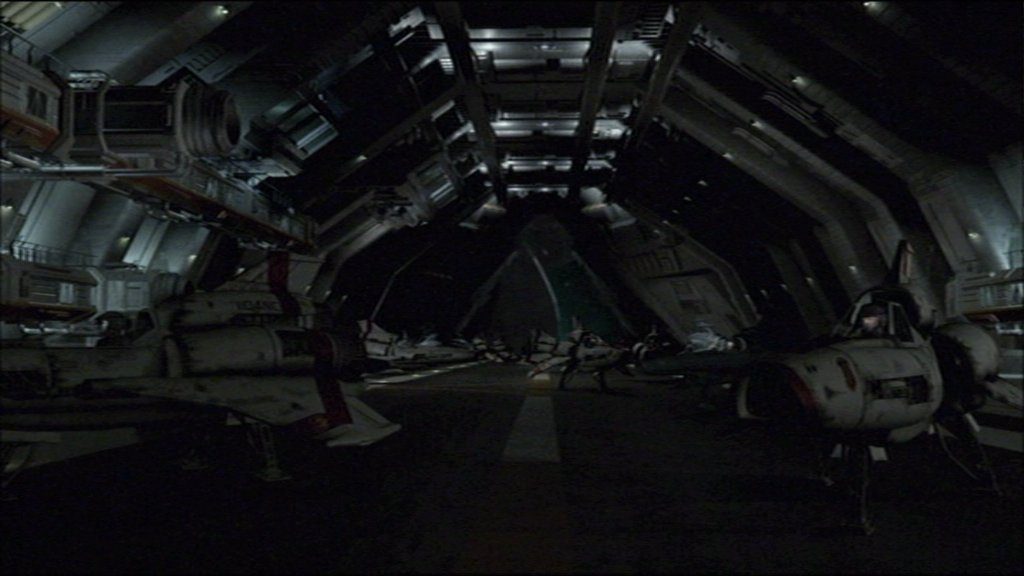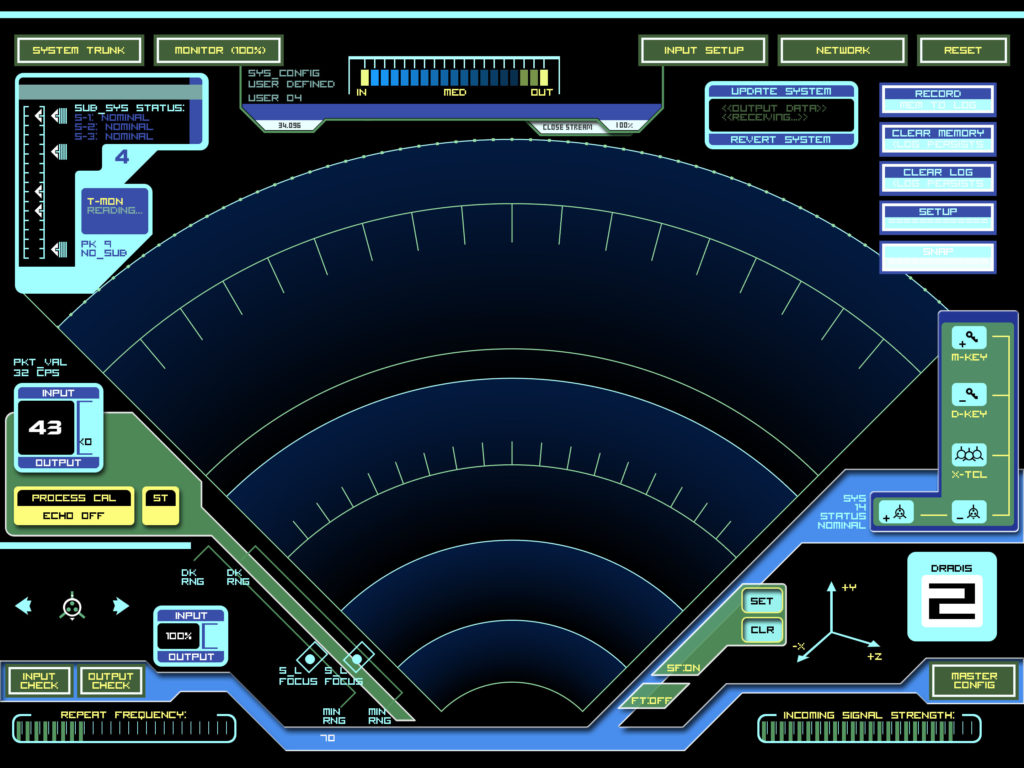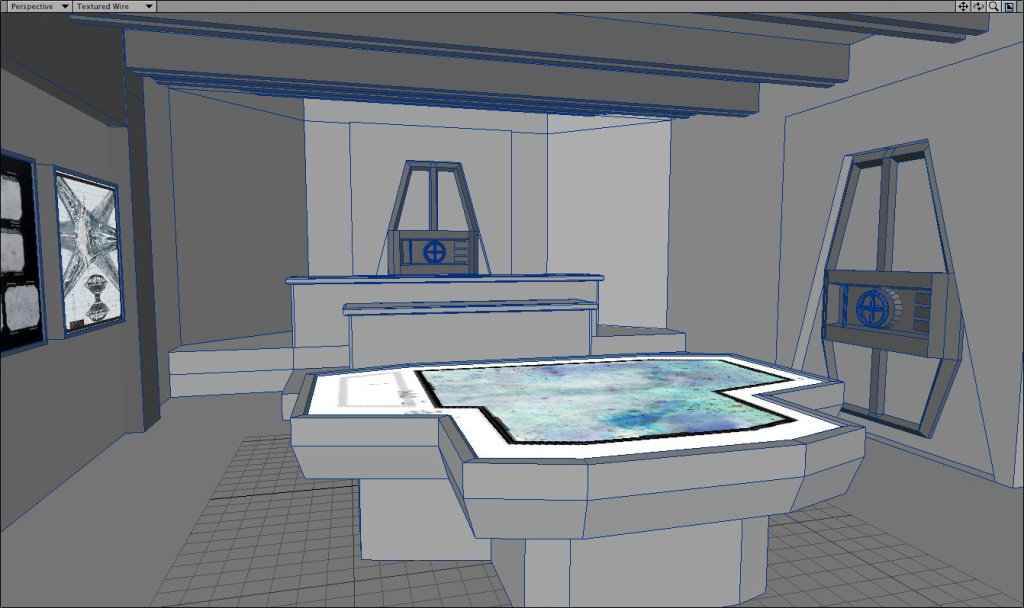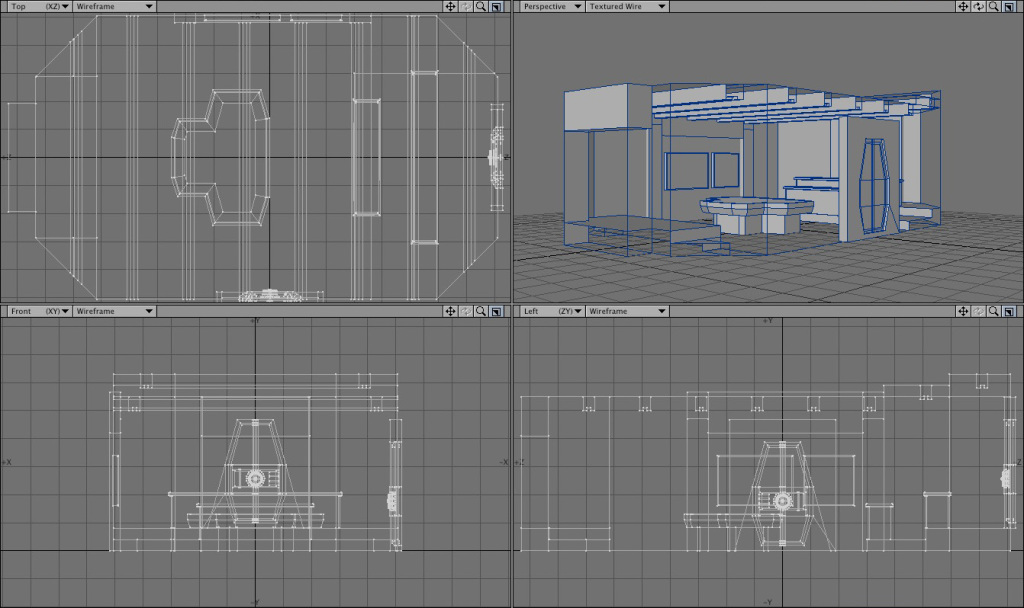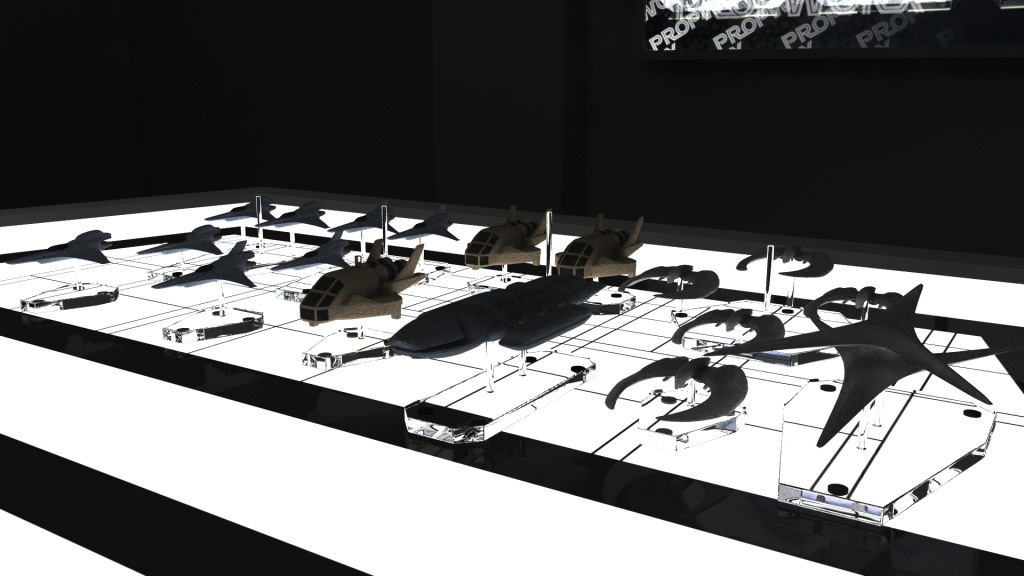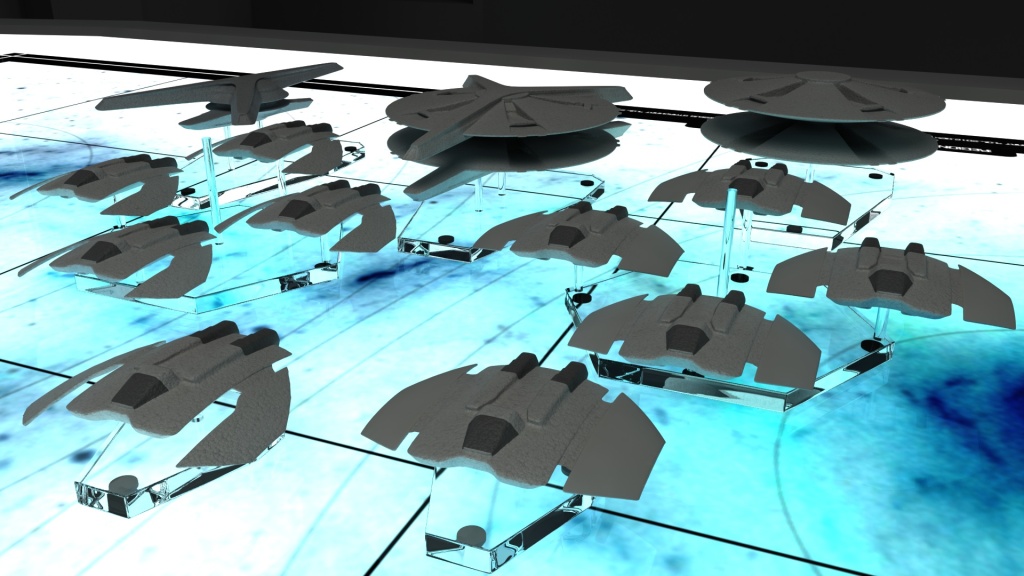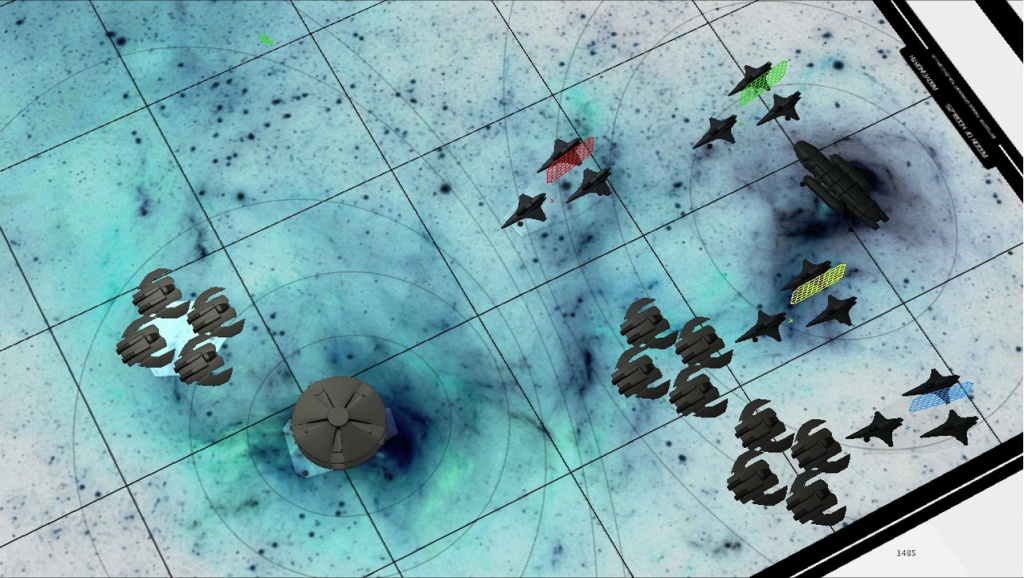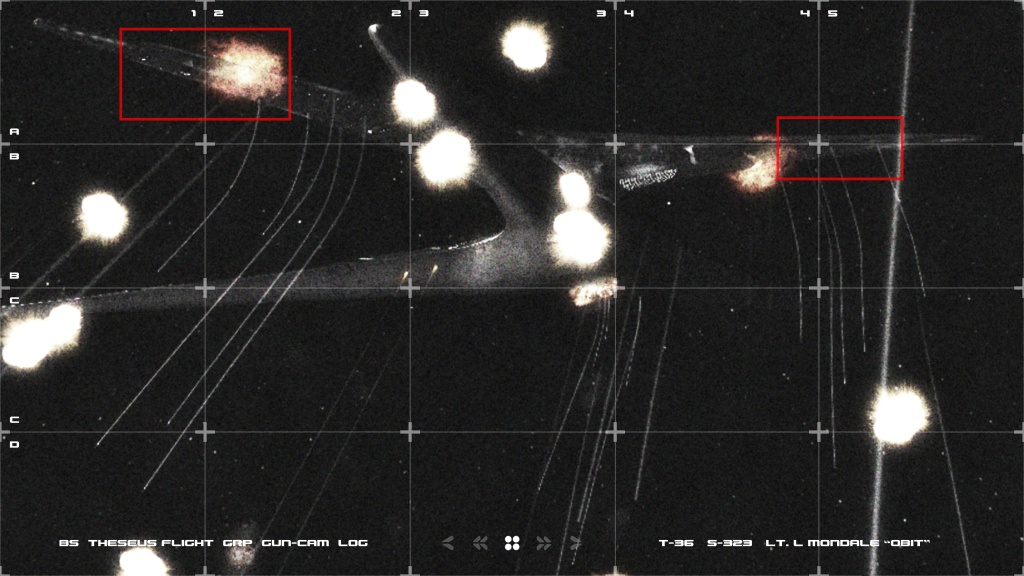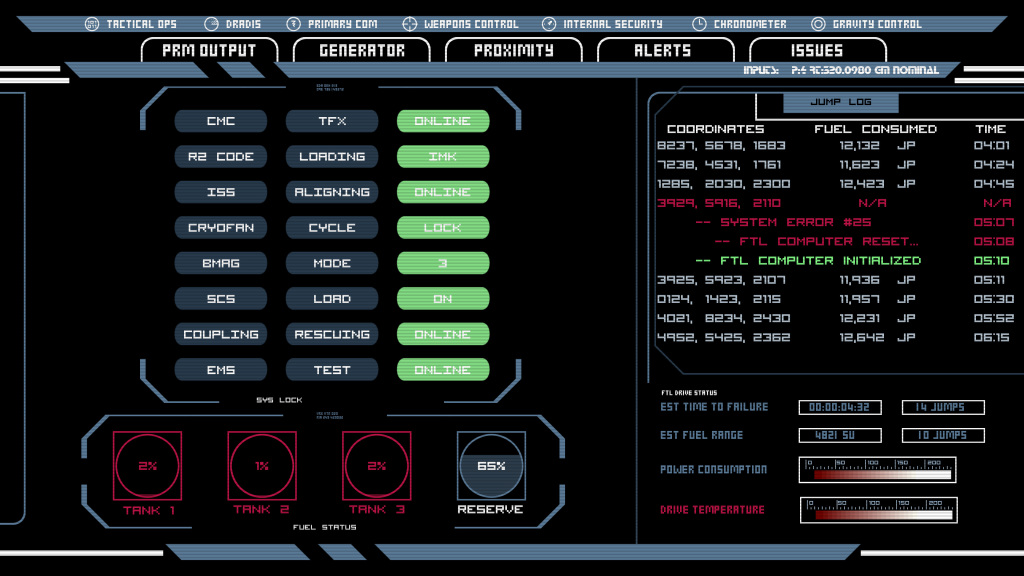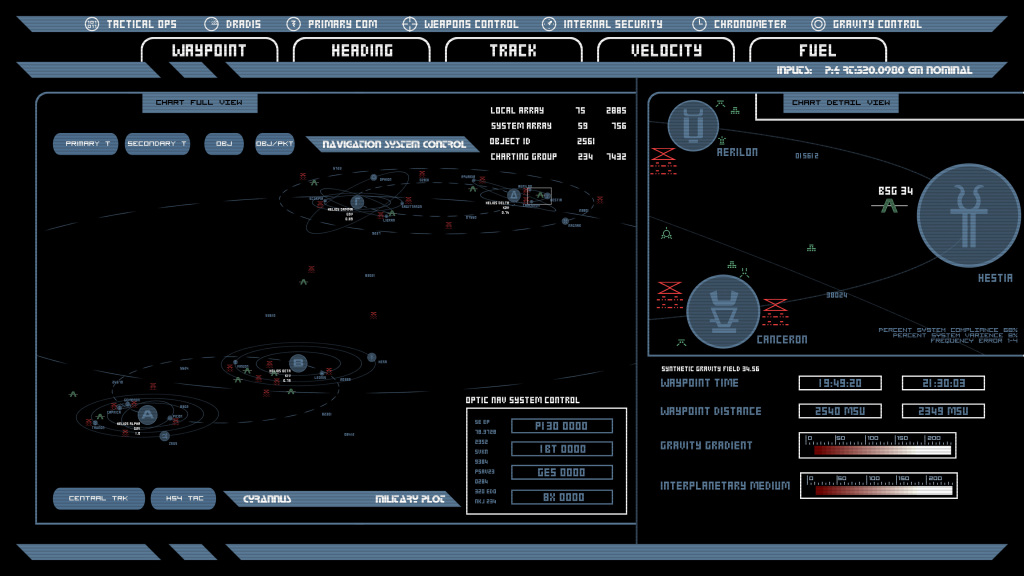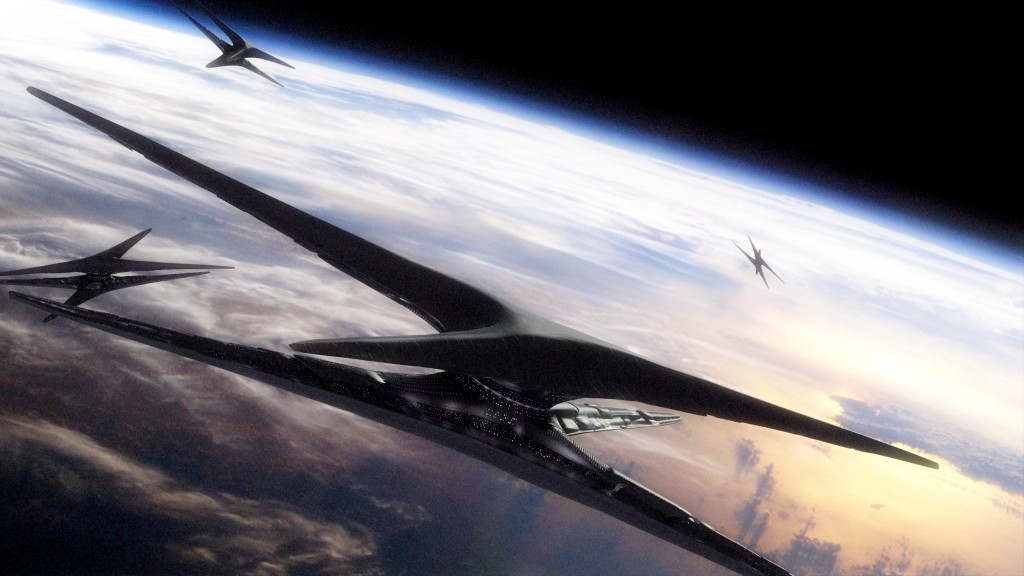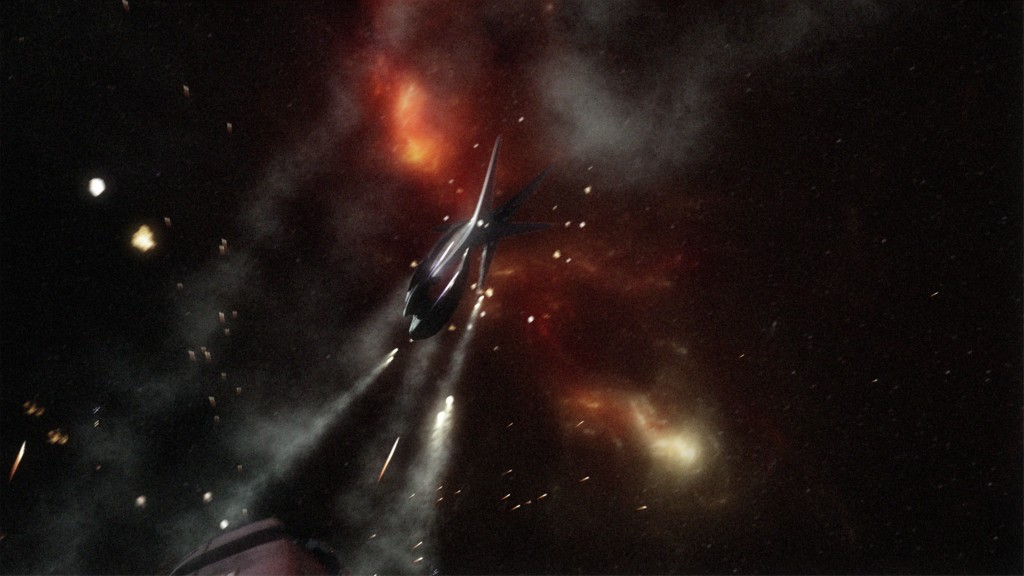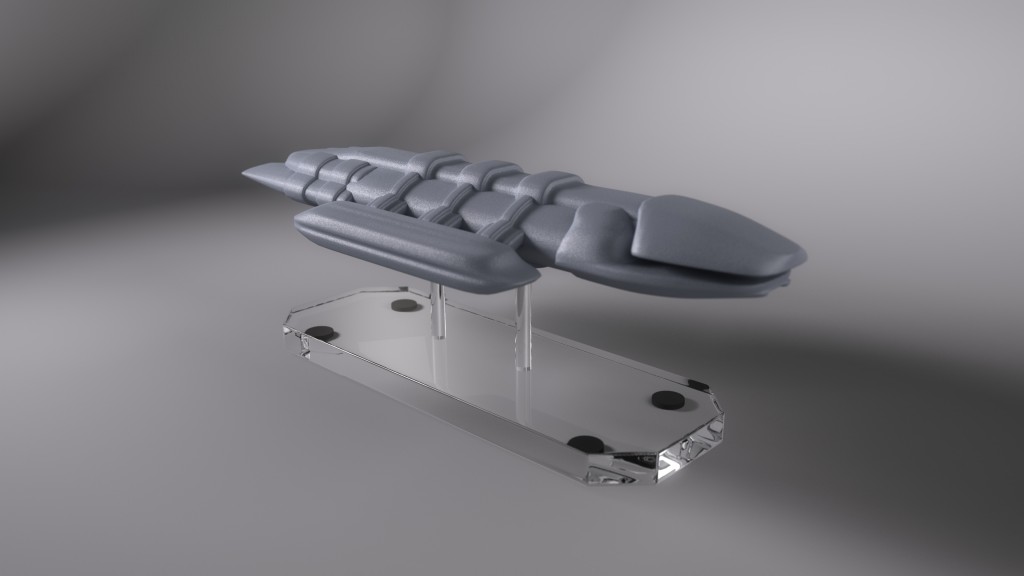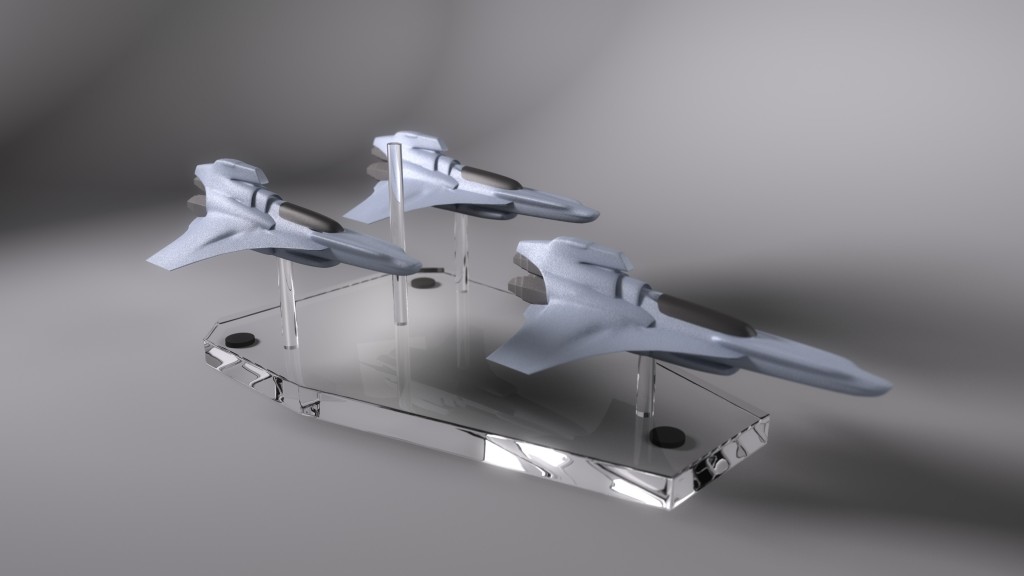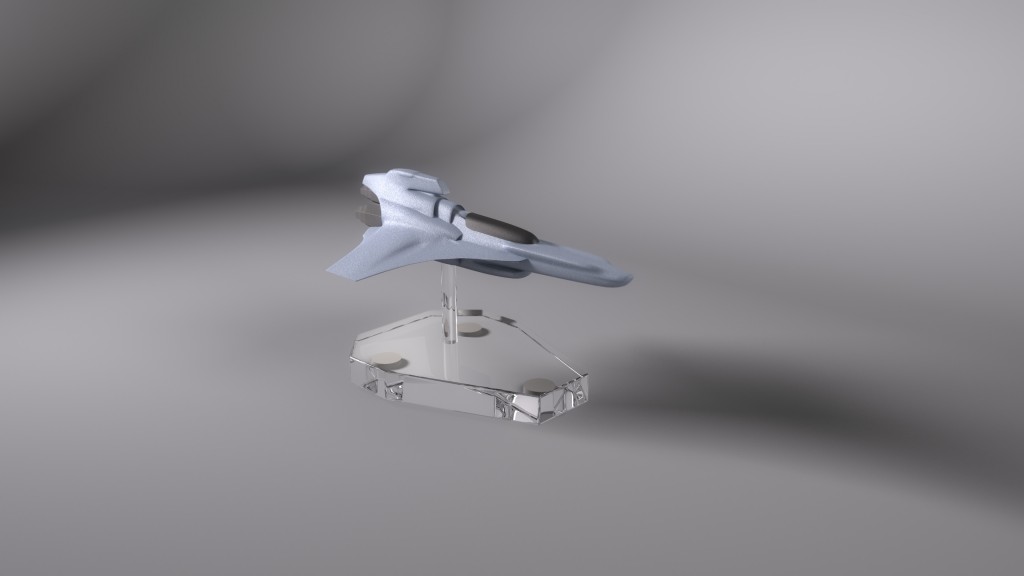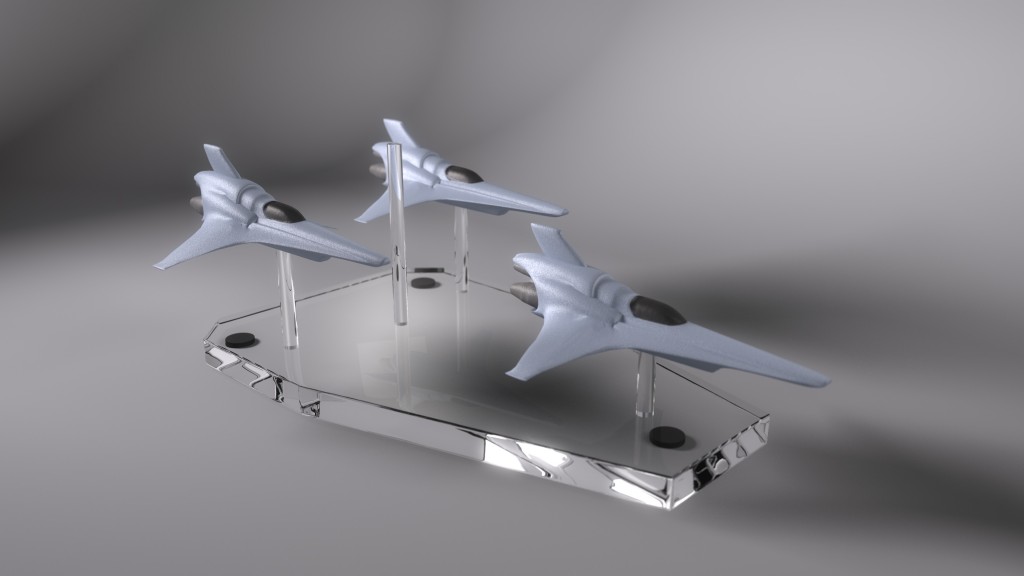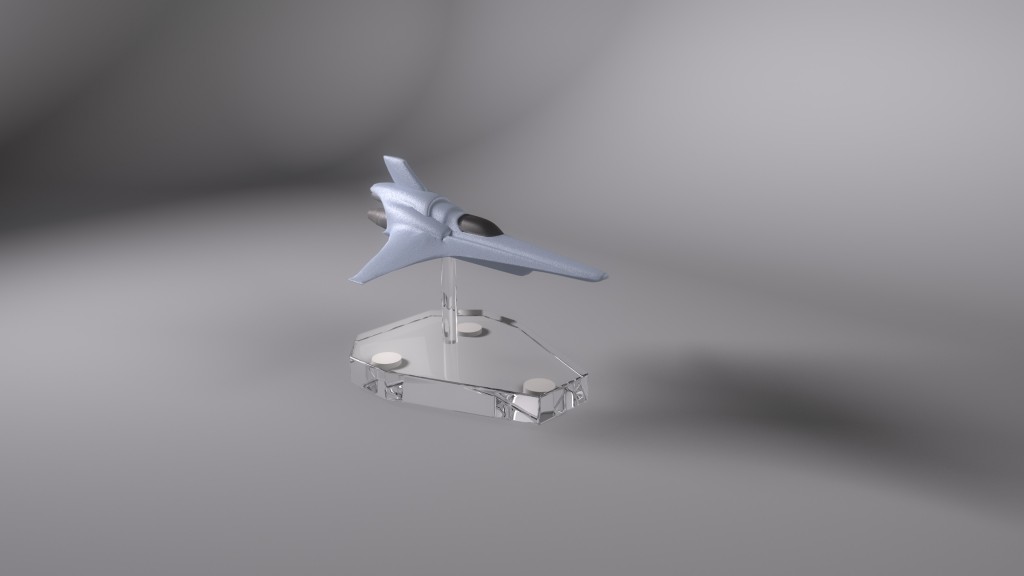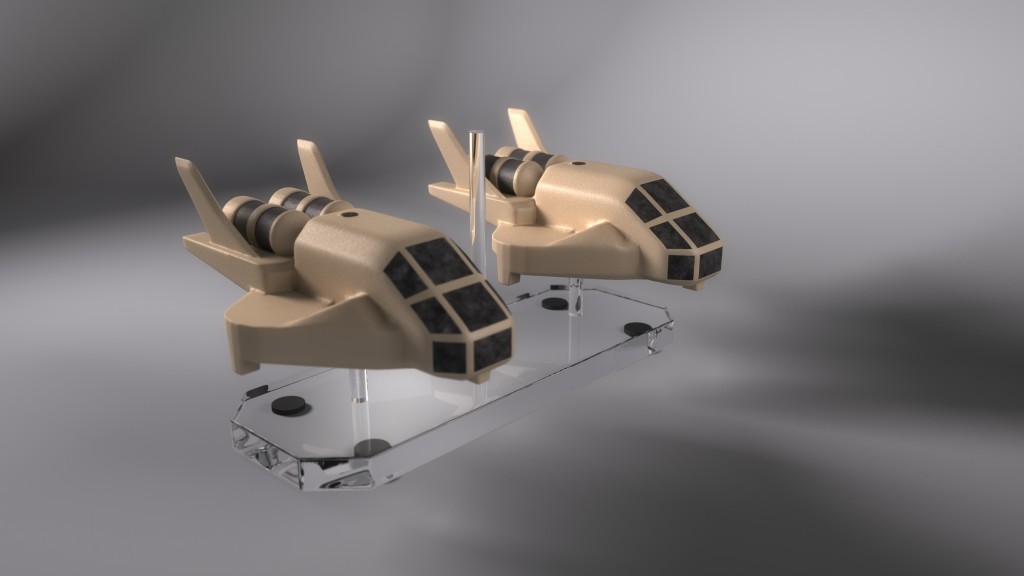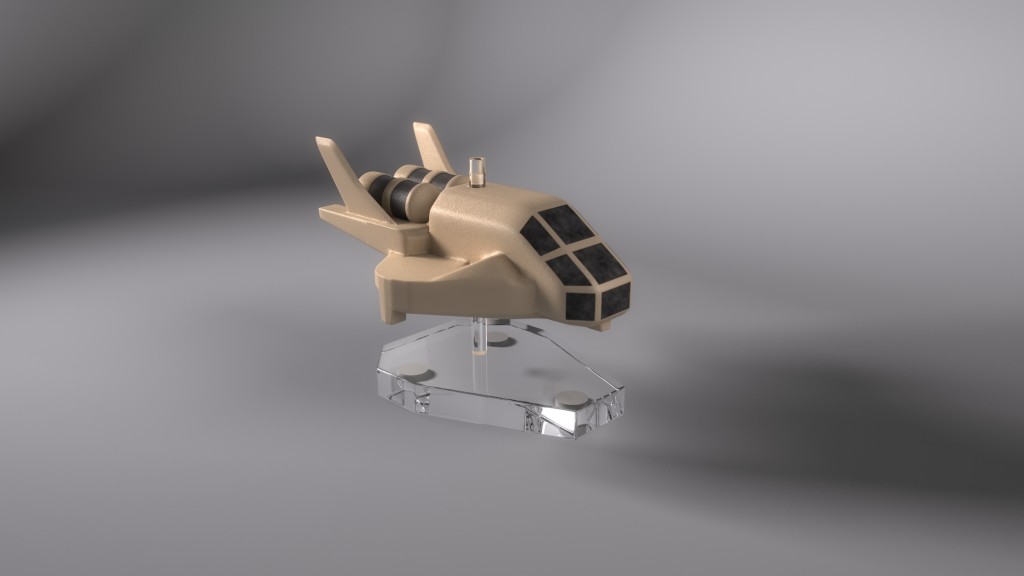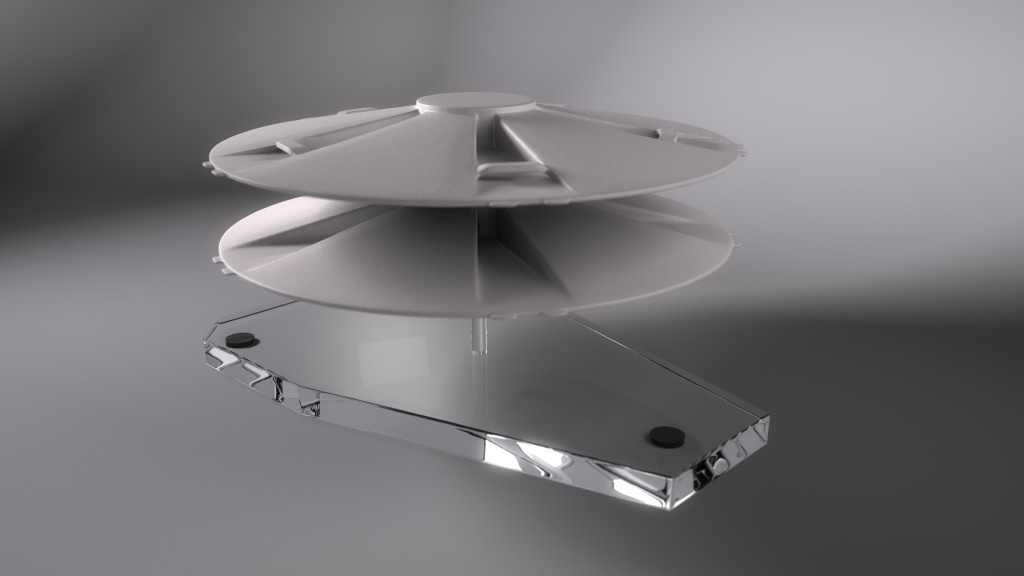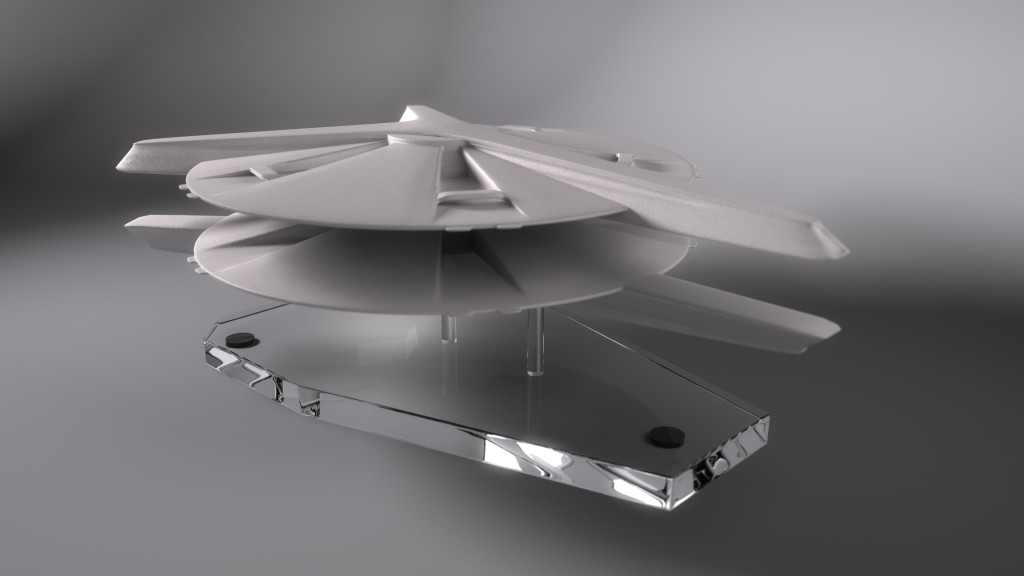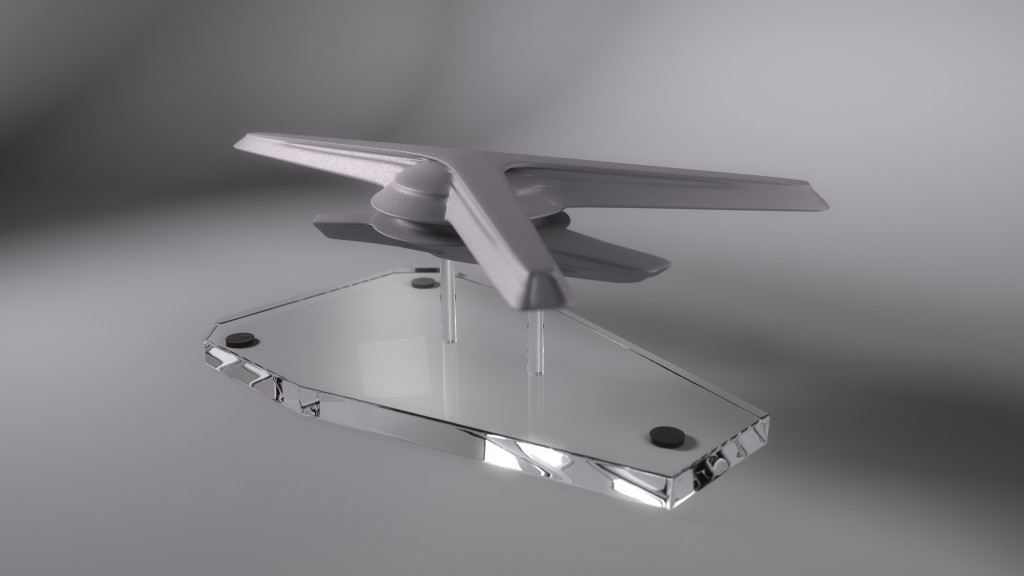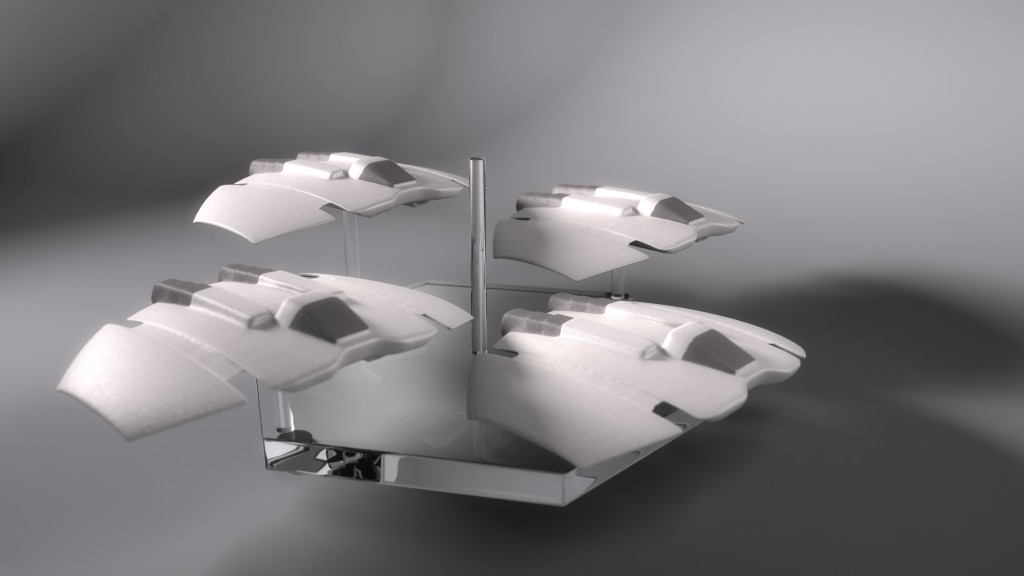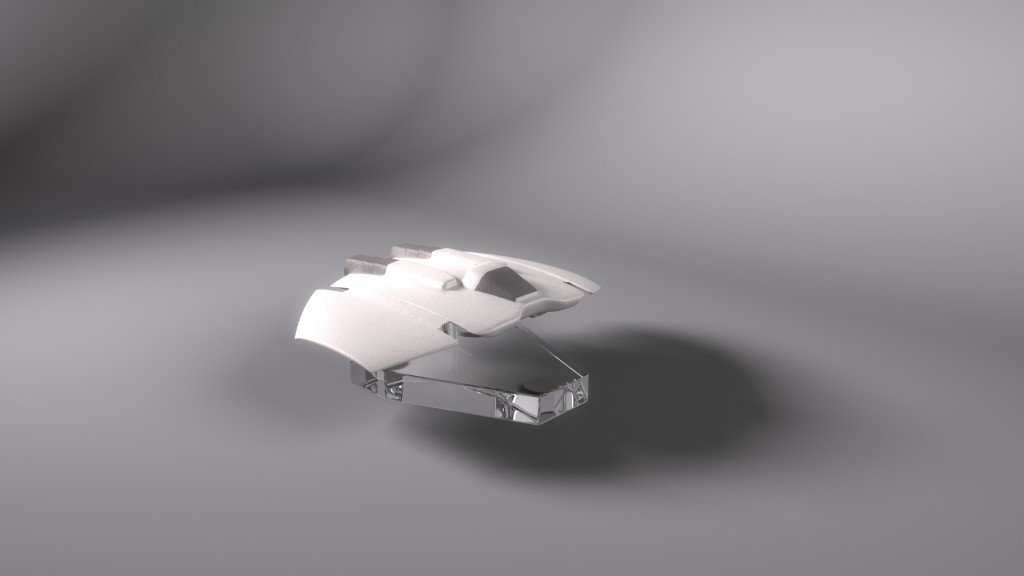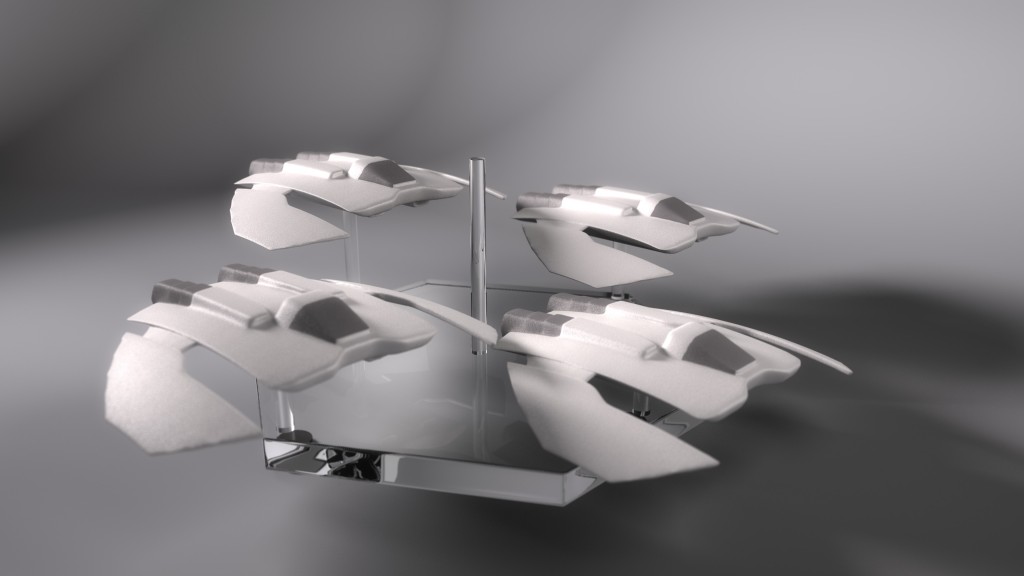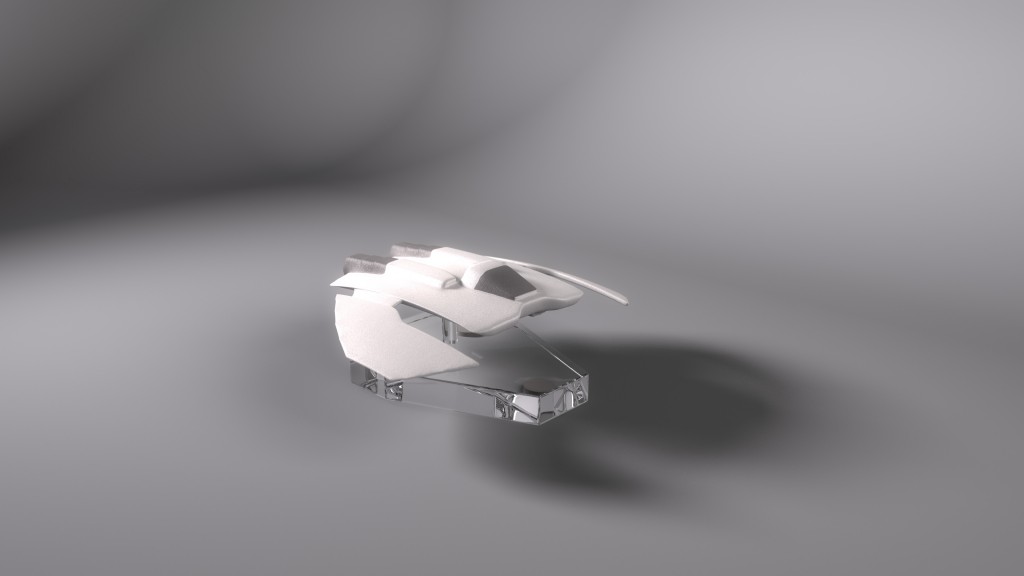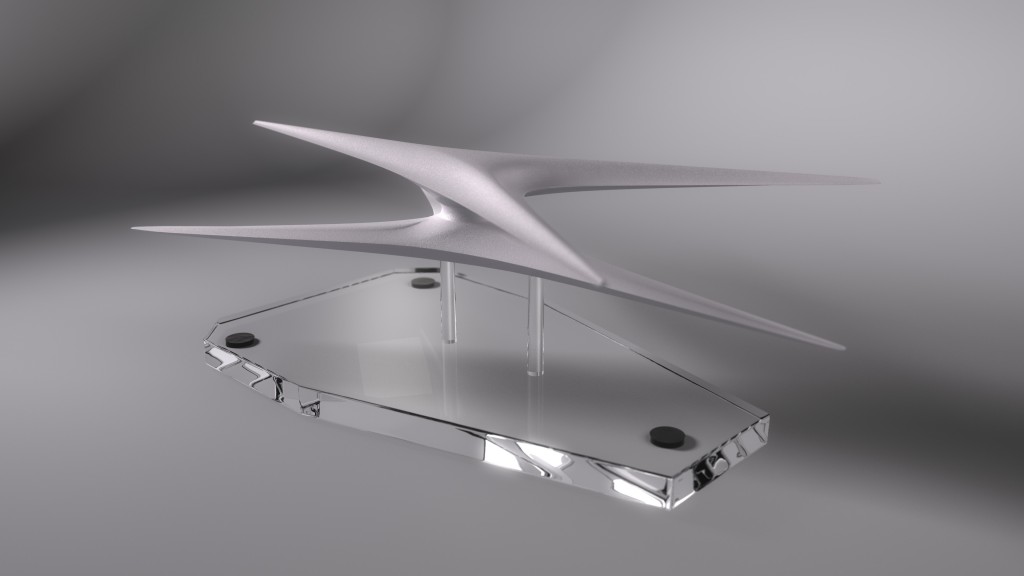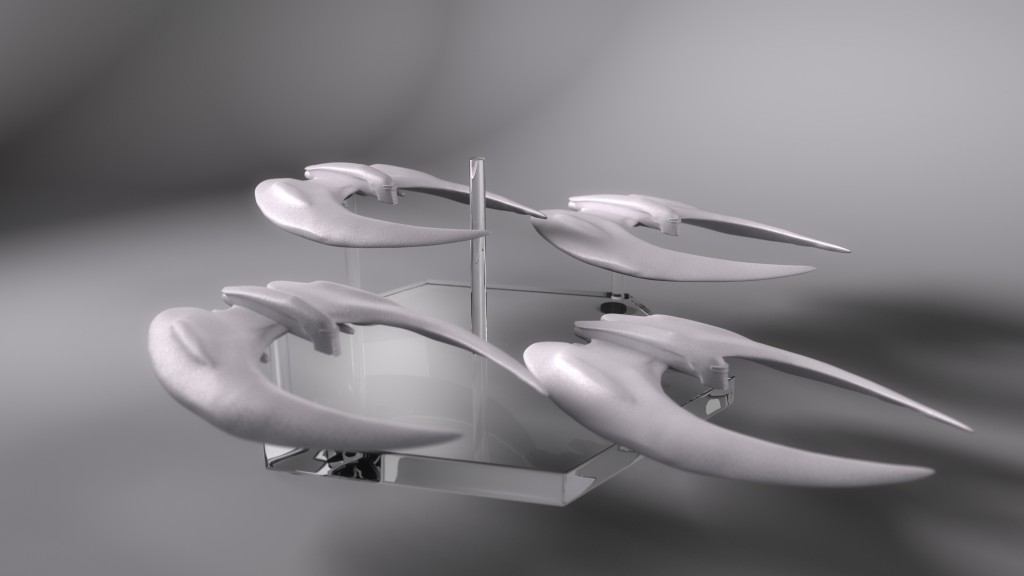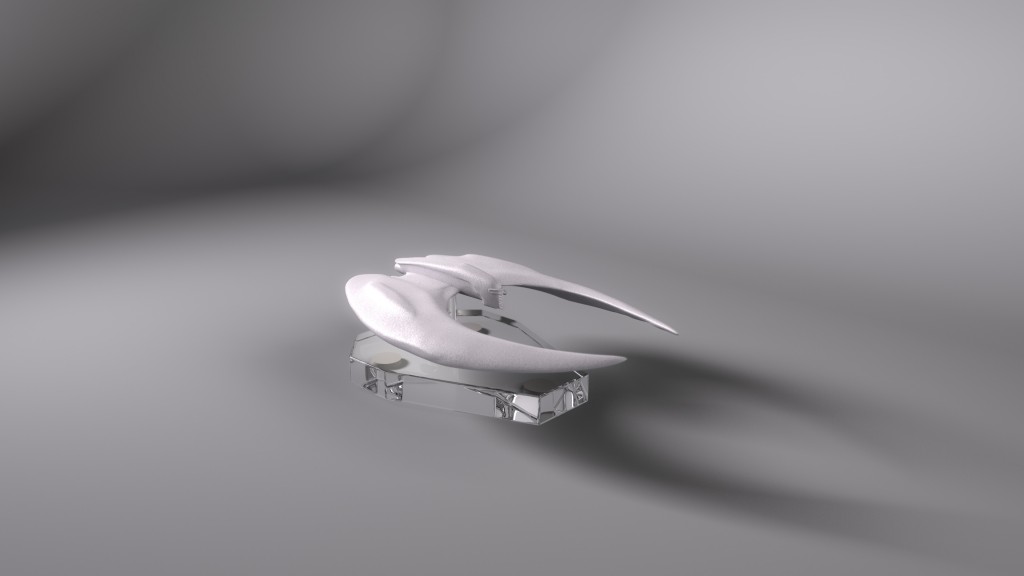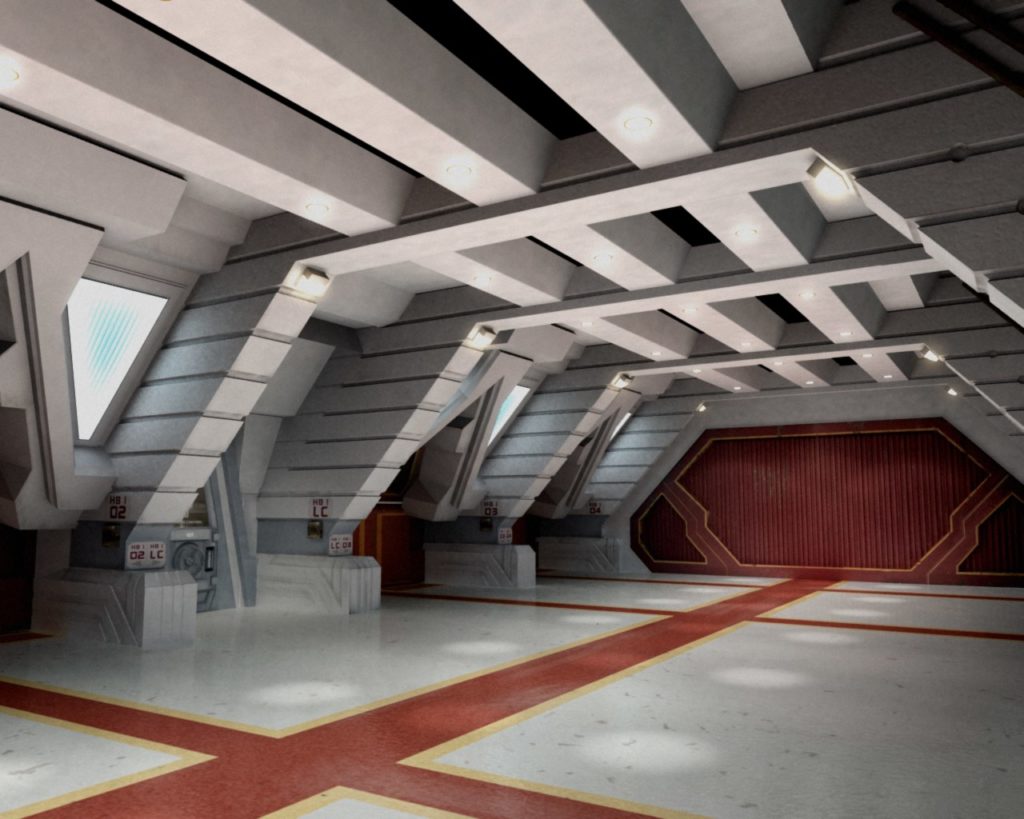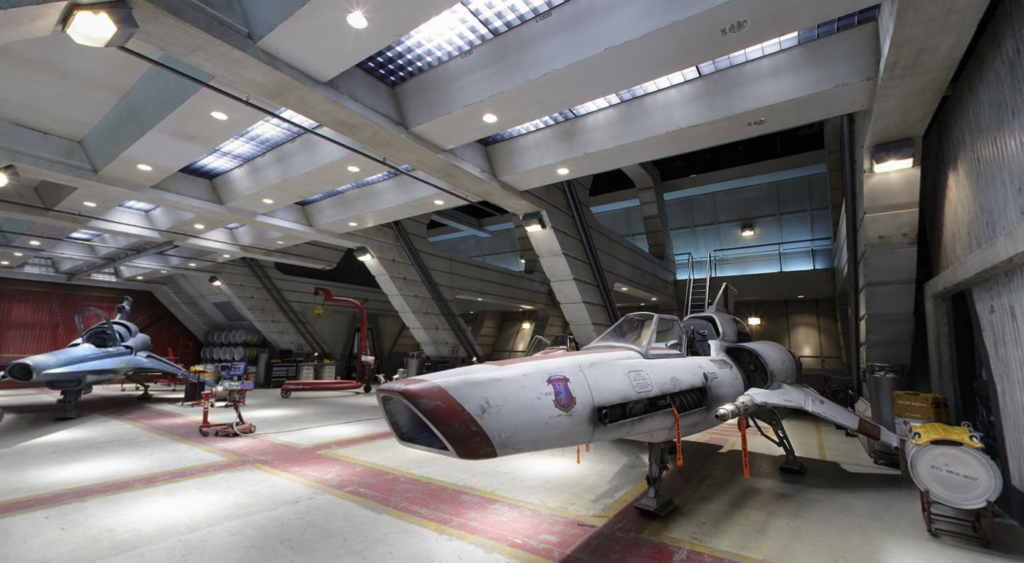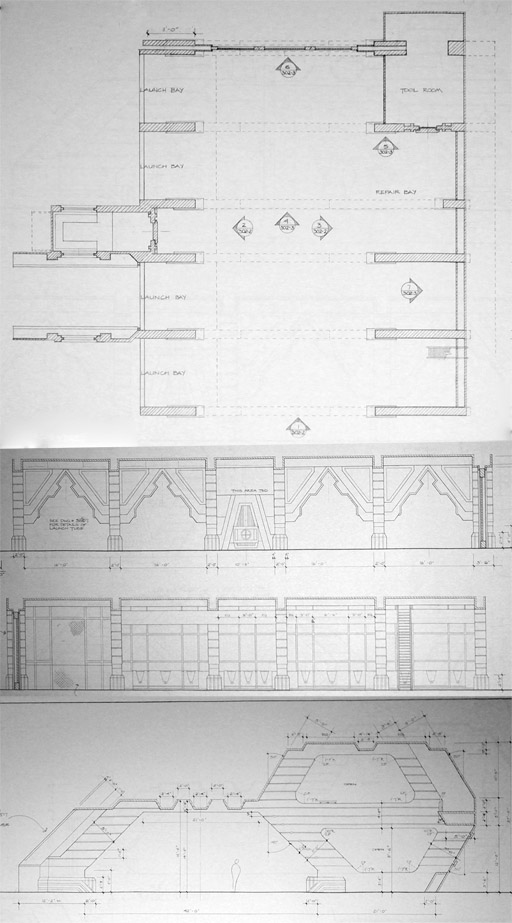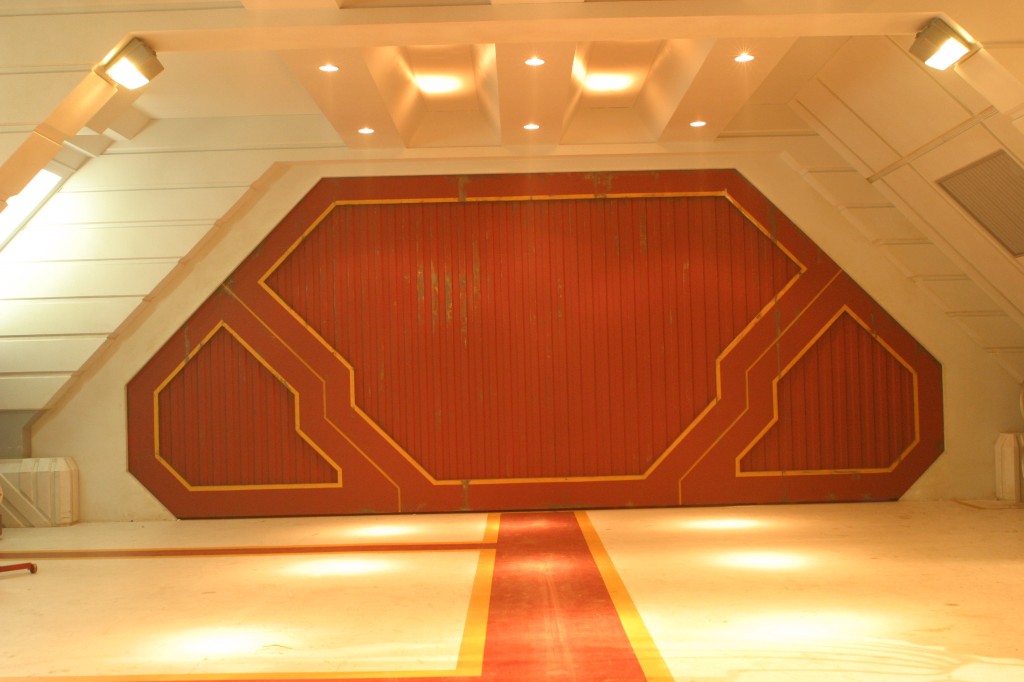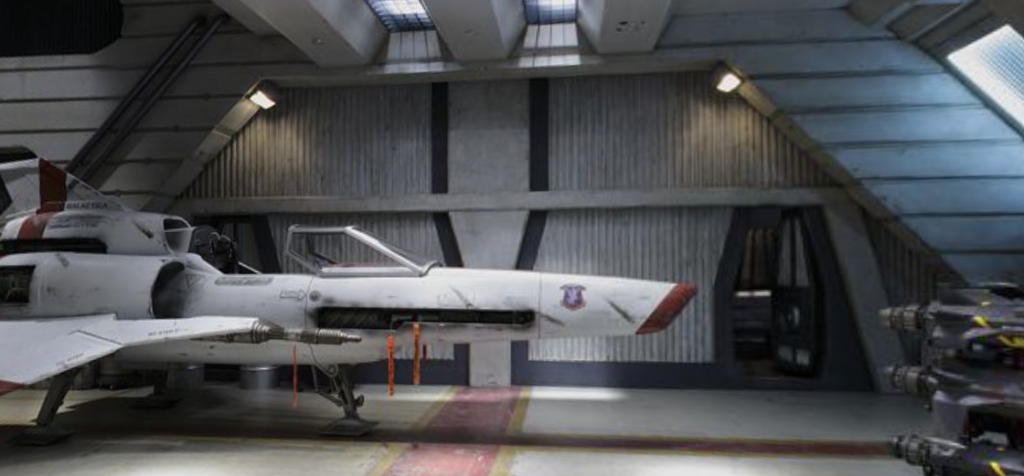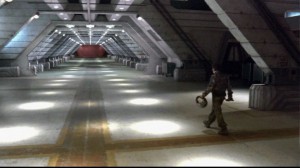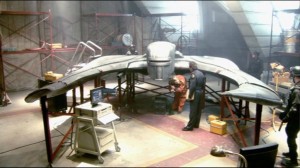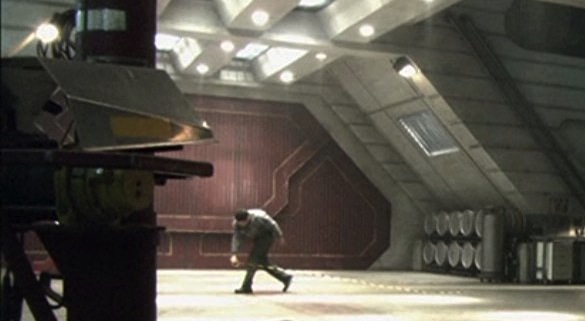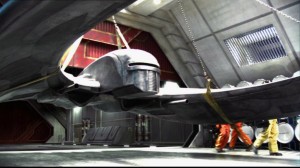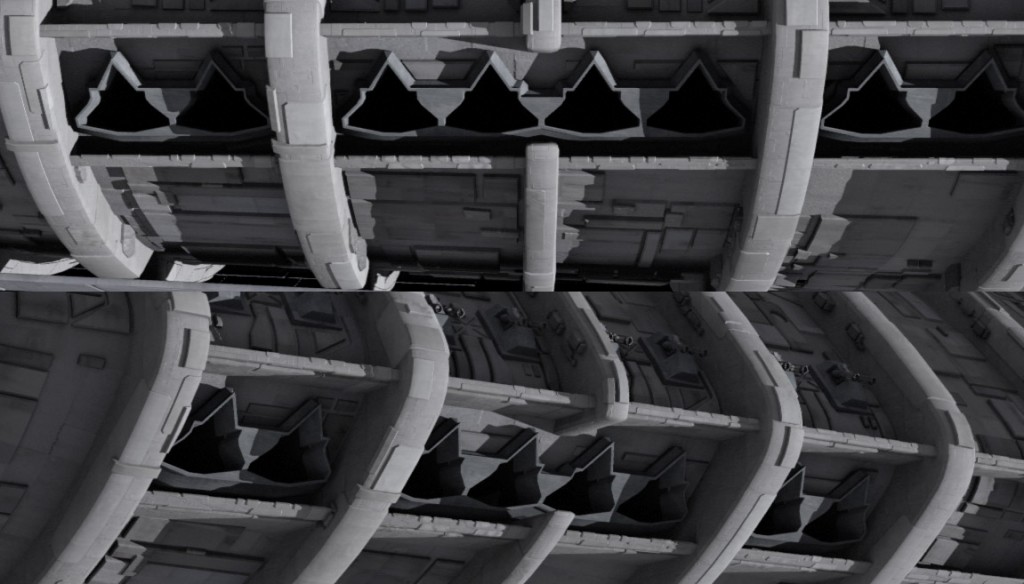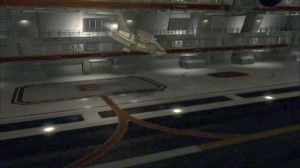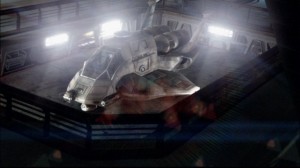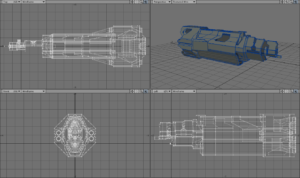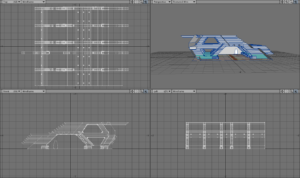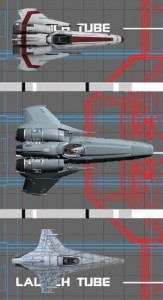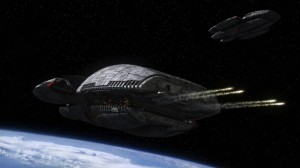And here we are again. And so much faster! This time, we’ll be going over the hangar of the Battlestar Pegasus, our first upside-downy hangar, and also the final canonical hangar.1Yes, there’s also the Osiris, but we see very little of it, and it seems pretty straightforward; There’s an airlock at the base of the aft fantail for launching and recovering, the whole bay seems to depressurize, and there are Viper tubes opening to the sides near the top of the ship. There are apparently elevators somewhere to take the Vipers from the hangar up to the tubes, but they aren’t obvious in the virtual set. There, write-up done.
Exterior:
The Pegasus has doubled-up flight pods. On top is a landing deck aligned with the main axis of the ship, but attached to the bottom is one which is, relatively speaking, upside-down. In between is a narrower area that joins the two sections, and this is where the launch tubes are, square in the middle between the dorsal and ventral2The mnemonic I use is that dolphins and sharks have “dorsal fins” which are on top of their body; thus “ventral” is the bottom decks. The launch tubes are all in a single row, but alternate between being aligned with the upper and lower decks.

Like Galactica, Pegasus has forty launch tubes per pod. They are in three groups, with fourteen tubes on the ends and twelve in the middle. The gaps between them are about six launch tubes wide (or, alternatively, as wide as three Galactica-style aircraft elevators).
There is one other minor detail, which I don’t believe has been identified publicly before. I found it when I first began researching this post, and I could hardly believe my eyes when I stumbled onto it.
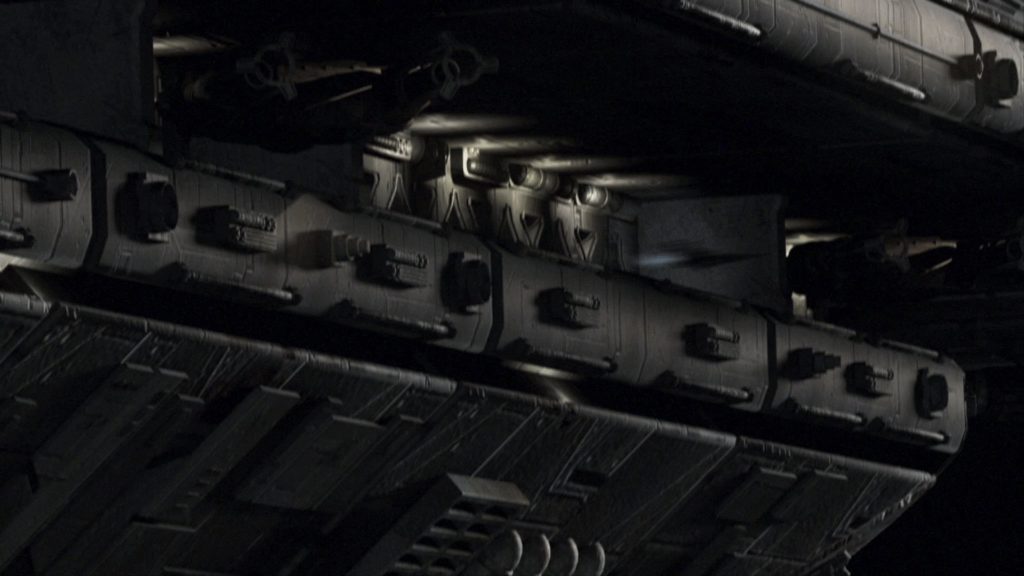
Do you see it? Zoom and enhance!
Once I noticed, I looked back at the orthographic renders provided through Modeler’s Miniatures and Magic. Now that I knew to look for them, I could see them easily. So let me amend that last statement.
Pegasus has forty launch tubes per pod— 37 Viper launch tubes, and three Raptor launch tubes. The Raptor tubes are the forward-most tubes in each of the three groups. They are, apparently, compatible with Vipers as well, given I only noticed they exist because one caught the light from the engine of a Viper launching from it. We never saw one used to launch a Raptor, but we only ever saw a Raptor in the act of launching from Pegasus a couple times, so that doesn’t mean much. It’s a little tough to be sure from the angle, but I suspect they’d also accommodate the “Assault Raptors” with additional weapons mounted, and the Blood & Chrome version. The forward aspect of the various version of the Raptor aren’t that different, and the silhouette of the tube doesn’t seem to conform very tightly.
The gap between the three clusters of launch tubes is about three or four Galactica-elevators in length, suggesting either multiple adjacent elevators, or that Pegasus has fewer, longer elevators. What we see in the “Razor” suggests the elevators are the same as those on Galactica, though not conclusively.
There’s a cutout on the dorsal pod, directly under the ship’s nameplate. The majority of the time, it was filled with nondescript tanks and greebles. In the shipyard sequence of “Razor,” this cutout was transformed into a sort of exterior loading dock. I’m going to ignore it, because I don’t understand what it could be for, aside from making the ship look like a hive of activity. If it’s a pass-through to the landing deck, it’d be just as easy to land ships normally from the ends. If it opens to the interior of the ship, anything being delivered would have to be taken around the open landing deck and, again, it’d make more sense to deliver it from the regular landing area inside of the pod.
Interior:
The Pegasus hangar deck was seen twice, in “Resurrection Ship, Part II” and “Razor.” Both times, it was a redressed version of the Galactica deck. In “Resurrection Ship,” they kept the lighting dim and avoided showing as much of it as possible. Indeed, aside from plot logic, the only indication this was the Pegasus deck was that they added the double fluorescent light fixtures to the hangar arches. They probably didn’t want to paint themselves into a corner so they kept things as vague as possible.
In “Razor,” since they spent a good deal more time there, they used the whole set. In addition to the light fixtures, the set was also un-distressed, the hangar doors were painted silver and blue-gray instead of red, the wayfinding signs, phones, and intercoms were replaced with ones using the Pegasus graphic design language (complete with futuristic Eurostyle rather than Spaceage, which was standard on Galactica), and the Galactica-style manual doors and the launch tubes were hidden by strategically placed fighters and piles of crates. The scenes depicted were also generally shot with angles and compositions that downplayed the overall arrangement of the set.
Beyond the set itself being obscured, there’s also very little use of CG set extensions. We see an aircraft elevator, but the far side is in shadow, so it’s difficult to tell anything about its size or what may be beyond it. There’s also one shot of an additional length of CG hangar, but it’s brief and out-of-focus, suggesting the production team took into account that the layout should be noticeably, if subtly, different from Galactica, even if it wasn’t worth it to construct it in full. Indeed, if it weren’t for the CG Raptor visible in it (the big giveaway is the black canopy glass), I would doubt it was a CG hangar extension at all.
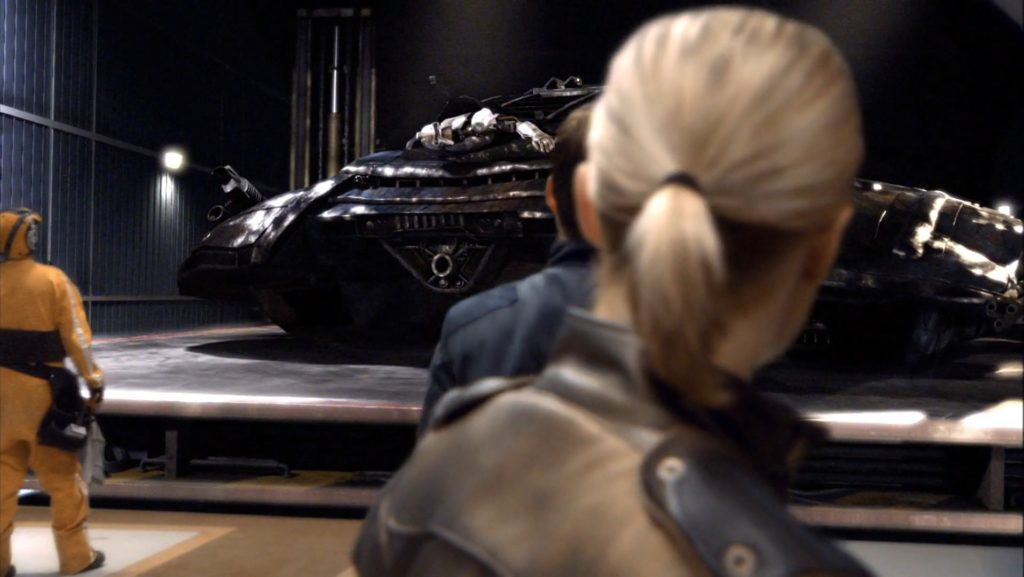
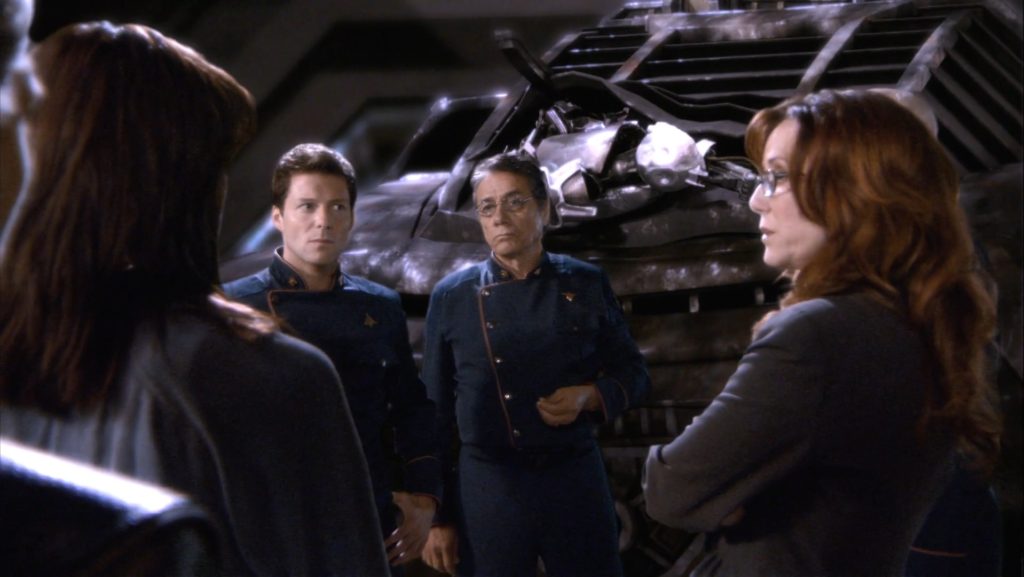
Landing Deck:
The Pegasus CG model was not overbuilt like Galactica, given that it was always going to be a secondary ship and not the focus of every episode of an ongoing series. Thus, the original Pegasus model didn’t have any landing deck detailing, aside from some small suggestions at the ends, where they’re most likely to be seen. There are relatively few angles that allow you to see down the length of the pod from the outside.
Since “Razor” featured the Pegasus more heavily, the model was done up a bit,3The Pegasus had a great many one-off modifications which were not incorporated into the main model, and thus were only ever seen once or twice each in shots where they were specifically called for. These include large fixed cannons in the bow in “The Captain’s Hand,” an extra gun battery on top of the flight pod in “Exodus, Part II,” and the external loading deck on the flight pod and bow-mounted reversing thrusters, both in “Razor.” Personally, aside from the bow battery, I ignore all of these when imagining the “real” Pegasus. adding interiors to the dorsal and ventral hangars. They’re based on the Galactica hangar deck, featuring similar jetways and other details. Oddly enough, we also see access airlocks which use Galactica-style manual doors, rather than the automatic pocket doors that are normally seen on Pegasus. I suppose it makes sense. When you have a door that opens to space, you probably want it be pretty easy to close and seal manually.
Side-note: While there was only one shot of the ventral hangar, it was smooth and had no zooms, so I was able to get a decent photogrammetry solve.
Even in “Razor,” we don’t see the landing deck in much detail, but we do get some suggestions of what may be the aircraft elevators on the dorsal deck. It’s tough to gauge the distance, so it’s hard to see if or how they match up with the gaps between launch tubes, but we’ll assume the elevators do. There are two kinds of outlined areas on the side of the runway which should have the elevators, but it’s hard to tell if these are parking spaces or elevators.
Synthesis:
First off, let’s take the obvious stuff: There are two hangar decks in each pod, sitting floor-to-floor. I’d assume there’s a mechanism in the aircraft elevators allowing them to rotate, so you can directly move ships from one deck to the other without flying them out of the ship and around. The Viper launch tubes have elevators which drop them down to the pod’s centerline for launch. This might seem wasteful compared to just having two parallel sets of tubes, but I’d propose that this arrangement allows a second set of Vipers to be pre-loaded into the tubes, above the first wave of Vipers. Thus, when launching an attack, Pegasus can launch eighty Vipers per pod nearly as fast as she could if she had eighty tubes installed, but with half the launch mechanisms to maintain. A much more efficient solution, which also allows for greater storage space on the hangar deck.
The launch tubes aren’t tip-to-tip, as they are on Galactica, so each tube and berth will be made a bit wider. This also helps solve the problem that the Viper Mark VII is too wide to fit into the launch tubes on the Galactica set.
As an aside, there is just enough vertical clearance to accommodate the Blood & Chrome hangar deck as seen in that film. I kind of wish we’d seen less of the Pegasus in “Razor,” so I could steal more from B&C. I’d really love to be able to include those elevated control rooms. The multiple parallel hangars would also fit in easily, with the launch tubes being on a lower level. And don’t get me started on the CIC.4I’ve actually come around to thinking Pegasus had a larger fleet command center that we never saw used (perhaps it was being renovated during the refit, perhaps it was overkill without escorts, perhaps Cain just didn’t like it), and the room we normally saw was the bridge. My understanding that on modern navel ships, the bridge and CIC are two separate rooms, and it helps to explain why a massive flagship like Pegasus would have a CIC exactly the same as the Valkyrie, a ship a fraction of the size.
Here’s the hangar layout for the port flight pod.
I’ve decided to assume the Pegasus Viper factories are on the level of the hangar deck, above the launch tubes. There’s a lot of extra room, and it seems like a reasonable use for all that space, which is likely more than is needed for other other non-hangar flight pod stuff like ready rooms, racks, messes, and so on.
I’ve put three adjacent elevators between each launch tube section. There are doors dividing all three elevators, so they can be pressurized independently. Additionally, the middle elevator has side doors, leading to the factory facility and the connecting struts for transport to other parts of the ship. Since the middle elevator connects to the factory floor, it’s still useful even if the side elevators are being used so they can’t serve as pass-throughs. Again, I’ll imagine a pivot in between the dorsal and ventral elevators so ships can be rotated from one hangar to the other.
The storage endcaps also have doors connecting to the factory. In the three launching hangars, I’ll imagine a door on the walls next to the elevators opposite the tool rooms, where a launch tube was in Galactica (as luck would have it, in “Razor,” that tube is just barely out of view, and several extras walk in and out of it, as if it were a door connecting to launch control, the factories, and whatnot).
The fighter compliment of the Pegasus is a bit of an open question. We don’t know much, aside from “a lot.” Enough that the show stopped keeping track of Viper attrition when she showed up, and enough that Galactica had and maintained a full compliment of 80-100 fighters after she absorbed Pegasus’s squadrons, even with losses sustained in… well, there was only one battle on-screen, but I’m sure at least one Colonial fighter had to be shot down in the season 4 premiere, never mind any possible between-episode encounters, suggesting they had spares in mothballs that they didn’t have the room to operate regularly. The only hard numbers we get are in “Razor,” where it’s reported that 32 Vipers were destroyed and 61 were “badly” damaged, but there’s not much to go on regarding what proportion of Pegasus’s wing these 93 ships represented, and whether that was a full load or if she didn’t leave space dock with a complete set (there were a lot of Vipers and Raptors parked in open space on the dock next to the ship), nor what it might’ve been when they met Galactica six months later, since Pegasus was fitted with a Viper factory on-board. Likewise, all we have to go on with Raptors is that Galactica had less than ten before Pegasus arrived and more than that after. Just to give me some basis for decision-making, I’ll assume the distribution is the same as I decided on for Galactica, with about one Raptor for every four Vipers.
Using our same old method of dropping in a ship everywhere there’s an empty berth, we can get this:
That’s 68 Vipers and 16 Raptors in the dorsal hangar, and 67 Vipers and 17 Raptors in the ventral hangar. That’s a flight pod total of 135 Vipers and 33 Raptors, or 270 Vipers and 66 Raptors (or 336 fighters) total for the Pegasus. Like the Blood and Chrome version of Galactica, this is a conservative estimate; there’s a lot more space available that could be filled with additional fighter storage, given the squared-off shape of the hull and the massive amount of real-estate opened up by not having the launch tubes on the same deck as the hangar.
| ↑1 | Yes, there’s also the Osiris, but we see very little of it, and it seems pretty straightforward; There’s an airlock at the base of the aft fantail for launching and recovering, the whole bay seems to depressurize, and there are Viper tubes opening to the sides near the top of the ship. There are apparently elevators somewhere to take the Vipers from the hangar up to the tubes, but they aren’t obvious in the virtual set. There, write-up done. |
|---|---|
| ↑2 | The mnemonic I use is that dolphins and sharks have “dorsal fins” which are on top of their body; thus “ventral” is the bottom |
| ↑3 | The Pegasus had a great many one-off modifications which were not incorporated into the main model, and thus were only ever seen once or twice each in shots where they were specifically called for. These include large fixed cannons in the bow in “The Captain’s Hand,” an extra gun battery on top of the flight pod in “Exodus, Part II,” and the external loading deck on the flight pod and bow-mounted reversing thrusters, both in “Razor.” Personally, aside from the bow battery, I ignore all of these when imagining the “real” Pegasus. |
| ↑4 | I’ve actually come around to thinking Pegasus had a larger fleet command center that we never saw used (perhaps it was being renovated during the refit, perhaps it was overkill without escorts, perhaps Cain just didn’t like it), and the room we normally saw was the bridge. My understanding that on modern navel ships, the bridge and CIC are two separate rooms, and it helps to explain why a massive flagship like Pegasus would have a CIC exactly the same as the Valkyrie, a ship a fraction of the size. |

